INDEPENDENT SCHOOL MANAGEMENT
Decarbonisation for the school estate
Climate change and the management of risk
Reduce your school’s operational carbon footprint
Responsible investment is about sustainability, not compromise




Decarbonisation for the school estate
Climate change and the management of risk
Reduce your school’s operational carbon footprint
Responsible investment is about sustainability, not compromise



Welcome to the autumn edition of Independent School Management. Thank you for all your positive comments about the magazine.
In this edition, we focus on positive strategies to consider for the new school year.
The increasingly high temperatures recorded this summer, along with forest fires, floods and other natural disasters all spell out a clear message about the effects of climate change on the planet. This year may be the hottest in the past 100 years, but might also be the coolest for the next 100 years.
As medium to large businesses, schools have their part to play in reducing their own carbon footprint. But sustainability isn’t just about doing the right thing, aiming for net-zero in energy use can also reduce operating costs as it can lower your energy cost base too, after the initial investment.
We have a special focus of features that consider various green measures, including decarbonising your school estate (ceasing to use fossil fuels for the operation of the school’s heat, transport and power requirements), marrying a sustainable approach with your works programme, identifying and mitigating risks, and considering an ethical approach to investment (by avoiding investment in fossil fuels, but also on whether an investment business is involved in other areas such as tobacco, the arms industry, animal testing and gambling).
Across the water International school projects continue apace. If your school is considering an international iteration, it’s vital that you and your team are aware of the potential risks from the very beginning. Some of the key risks include:
• Reputational damage to the home school if the overseas iteration is unsuccessful or is mired in scandal
• Insufficient demand from inadequate prelaunch research that fails to predict the potential demand for places
• The risk of planning/managing an overseas school diverting
management time and investment away from the UK operation
• Parents at the home school feeling concerned that their school fees are being spent on the overseas school rather than on the one educating their child in the UK
• Local regulations can be complex, inconsistently applied and are always evolving, so require ongoing supervision. This absorbs both management time and expense.

Protecting the school brand is key. It’s imperative that you register your school's trademarks in countries of interest preproject to avoid an interloper stealing your legal identity there.
There will also be a need for project documents, including a ‘memorandum of understanding’, which helps discussions to reach an initial agreement with a potential project partner at an early stage, and sets out the intentions of the two parties. Another is a ‘heads of terms’, which sets out the main commercial terms of the project. The final ‘project agreement’ sets out a clear, practical and detailed framework for the relationship between the parties and the operation of the school prior to and after the launch of the school.
Apart from the potential financial benefits of a successful international project, the relationship between the home and overseas operations enables valuable opportunities for sporting and cultural links, exchanges of staff, and the development of an international community of alumni.
Back closer to home, key changes for the inspection of governance under the Independent School Inspectorate’s (ISI) new F23 have just come into effect. We
analyse the key changes and amendments affecting an independent school’s operation. One of the more significant changes is that single word qualitative judgements are being dispensed with: something that heads and teachers in the maintained sector have been demanding from Ofsted in their inspections, especially since the death of a headteacher in Berkshire after a harsh designation was assigned to her primary school.

Governance itself will not be judged by ISI, as with the previous framework. However, since the framework focuses on “the responsibility of the school’s leadership and management and governance to actively promote the wellbeing of pupils at the centre of ISI’s evaluation of the school”, this is very likely to lead to an expectation by the inspectorate of an extensive provision of evidence that demonstrates how this is achieved. Nothing is ever straightforward when it comes to ‘new’ and ‘improved’ frameworks.
To keep up with the latest sector news and people moves, follow us on Twitter @IndSchMan
Editor,We trust you will find this issue of Independent School Management informative and useful.
To keep up-to-date with the latest independent schools news, ensure you receive future copies and sign up to our newsletter, please visit our website.
independentschoolmanagement.co.uk
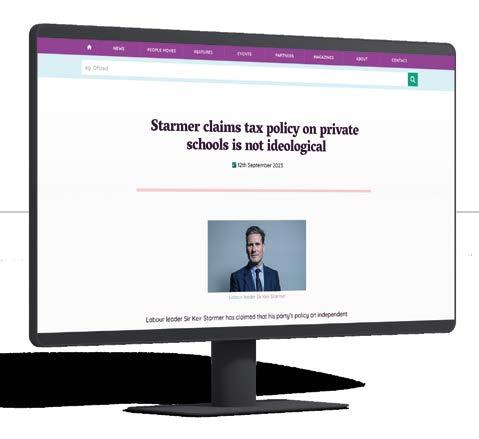
Chief executive officer
Alex Dampier
Chief operating officer
Sarah Hyman
Editor Andrew Maiden andrew.maiden@nexusgroup.co.uk
Reporter and subeditor
Charles Wheeldon charles.wheeldon@nexusgroup.co.uk
Advertising & event sales director
Caroline Bowern 0797 4643292 caroline.bowern@nexusgroup.co.uk
Business development manager
Steven Godleman steven.godleman@nexusgroup.co.uk
Event manager
Conor Diggin
Operations executive
Sophia Chimonas
Senior conference producer
Teresa Zargouni
Head of digital content
Alice Jones
Marketing design manager
Craig Williams
Marketing campaign manager
Sean Sutton
Lead developer
Jason Hobbs
Publisher
Harry Hyman
Investor Publishing Ltd, 5th Floor, Greener House, 66-68 Haymarket, London, SW1Y 4RF
Tel: 020 7104 2000
Website: independentschoolmanagement.co.uk
Independent School Management is published three times a year by Investor Publishing Ltd. ISSN 2976-6028
© Investor Publishing Limited 2023
The views expressed in Independent School Management are not necessarily those of the editor or publishers.
@IndSchMan linkedin.com/company/ independent-school-management
6-9 News in brief
10-11 Go your own way
12-13 Keep it simple
14-15 Cashing in Bursars should use deposit platforms
16-17 Why net zero?
Decarbonisation for the school estate
18-19 Weather the storms
Climate change and the management of risk
20-21 Onward march
Reduce your operational carbon footprint

22-23 The right choices
Responsible investment is about sustainability, not compromise
24-25 Beyond the small print
How parent contracts should work for your school
26-29 Standard bearers
Inspection of governance under the Independent Schools Inspectorate’s F23
30-31 Worldwide opportunities
Emerging market opportunities for international schools
32-33 Destination Dubai
The emirate is welcoming UK independent schools
34-35 Find your resilience
Overcoming daunting challenges
36-37 All change in the classroom?
A Labour government might redefine school recruitment models
38-39 Embrace apprenticeships

How they can be used as part of the school workforce
40-41 Make change positive
Protocols for making effective change while keeping stakeholders on board
42-43 Build a development office
Strategy for the effective launch of external relations
44-45 Beyond hope
Development should be at the heart of a school’s central management function
46-47 People moves
48-49 The last word
Suzie Longstaff of London Park Schools
Labour leader Sir Keir Starmer has claimed that his party’s policy on independent school taxation is not an ideological attack, Jewish News has reported.

Starmer was answering questions from Year 6 pupils on a visit to Independent Jewish Day School in Hendon, north London – and when the subject was raised he backed the policy outlined by Labour’s education secretary Bridget Phillipson to end charitable status and impose VAT on fees.
Starmer said: “Ending the tax break is not aimed at independent schools on any ideological grounds. It’s simply trying to answer the question of, if in your state schools you don’t have teachers in basic subjects like maths, then are you going to do anything about it?
“And if so, how are you going to pay for it? That tax break will be used to support the recruitment of 6,500 new teachers into state secondary schools in subjects like maths.
“Any parent, whether they send their child to an independent or a state school, would say every child deserves to be taught in the core subjects by a teacher who has got the relevant qualification. This is not intended as any reflection on independent schools. We want them to thrive and to work with them.
“It’s a way of ensuring we get enough
good teachers into secondary schools to make sure every child has the chance to thrive. My ambition, because we will have five missions in government, and one of them is about education and skills.
“One day, if we get this right, it shouldn’t matter whether you go to independent school or state school, and that every child will have the same chance, whichever school they go to.
“That’s not to the detriment of independent schools; on the contrary, I want to make sure every child has the best chance.”
Katharine Birbalsingh, head of Michaela Community School in Northwest London and known as Britain’s strictest headteacher, says private schools are scrapping GCSEs because “they are failing to meet the standards,”The Telegraph has reported.
Speaking to BBC Radio 4’s Today programme, Birbalsingh said: “If you do not perform at GCSE, then that is why they are doing this. Because over Covid, we learned what teacher bias does, about how the grades are then inflated. In particular, in the private sector, the grade sevens in the private sector went from 46% to 61%.
“And this move will allow them to do exactly the same thing again, which will advantage richer pupils, the pupils that can
afford £25,000 a year over the normal kids [at] state schools. And they will then get the jobs and get the positions of authority out there, having not achieved any kind of national standard.
“And this is the private schools pushing through an agenda, because they are failing to meet the standards that they should do for their pupils that is really important to note. People think that they are, but they are highly selective and they are not coming out with those nines or the sevens frankly for their pupils.
“And now they’re saying what we need to do is create our own exams because they are not performing at the level that they should do at GCSE level.”
Latymer Upper School, a private school in Hammersmith, west London, recently announced it is dropping all GCSEs apart from English and maths and creating its own qualifications.
Latymer’s deputy head Ian Emerson said that GCSEs “remain narrow and are marked according to rigid and limiting mark schemes”.
He said: “They reward rote learning rather than deeper, more original thinking. And they do not effectively teach students the core skills which are sought after by employers in the modern workplace.”
Earlier, Hampshire private school Bedales stated that it plans to move to its own ‘Bedales Assessed Courses’ in most subjects.
Nord Anglia Education has officially launched Oxford International College (OIC) Brighton, a new independent day and boarding school for pupils aged 13 to18.
The Lord Lieutenant of East Sussex, Andrew Blackman, hosted a special tree-planting ceremony to commemorate the opening of the school, after which the Mayor of Brighton & Hove, Jackie O’Quinn, officially opened the new building before attendees were taken on tours of the school campus.
The school, which will expand to accommodate a maximum of 400 boarding and 100 day students over the coming years, is built upon the model of its sister school, Oxford International
College, in Oxford.
OIC Brighton offers pre-GCSE, GCSE and A-level courses for British and international students and enrolled 160 pupils for the start of term.
Tess St Clair-Ford, founding principal of OIC Brighton, said: “We are thrilled to welcome our first cohort of students to our newly renovated Brighton campus as they
embark on their learning journey with us. Following extensive investment, all of our students benefit from state-of-the-art facilities thoughtfully designed to support their learning, while our enviable location in the British countryside, close to the city of Brighton and the coast, provides our students with many opportunities to relax, study and stay fit.
“Our passionate teachers, who are leaders in their fields, will guide our students to stand out as pioneers, original thinkers and highly skilled learners. By matching the ambition we see in our students with an equally ambitious and motivated teaching team, we will build a culture of dynamism, making our college an inspiring place for both learning and teaching.”
Andrew Fitzmaurice, chief executive of Nord Anglia Education, commented: “OIC Brighton will be an outstanding school, focused on high-quality

teaching and learning, academic excellence and wellbeing. Our new school is an international place of learning dedicated to nurturing students’ global citizenship, confidence, resilience and team spirit.”
“We are a school community with wellbeing at its heart. I truly believe that there is a deep connection between academic progress and strong mental health and wellbeing. This focus on wellbeing is at the core of everything that we do as a school; creating an environment where all our students feel fully supported and ready to take on any challenge.”

Eton College is partnering with state school trust Star Academies to open free sixth form colleges in Dudley, Middlesbrough and Oldham which will educate young people from deprived communities in the Black Country, Teesside and northern Greater Manchester, supporting them to achieve places at the very best universities. The colleges will be called Eton Star Dudley, Eton Star Oldham and Eton Star Teesside.

Partnerships between independent schools and the state sector offer little benefit for the state schools involved, a report has claimed. Of the state schools polled for the report, only 3% said they benefited
from access to private schools’ facilities and just 1% benefited from teacher secondment. Many of the partnerships involved little more than joint football matches or invitations to school concerts, the report stated. On the plus side, some state schools reported events aimed at helping state school pupils with university applications, and week-long summer schools at the private institutions. Freedom of Information requests were sent out to 400 state schools, with 277 replying. Of those, 36 (13%) said they were involved with a partnership with a school in the independent sector.
£13M
The bill to the taxpayer for the children of diplomats attending UK private schools amounts to £13 million annually, The Times reported. The Foreign Office, which funds the scheme, also spends an additional £25 million annually on the fees of schools overseas for children whose parents are posted there. The average cost for the fees of the 514 diplomats’ children attending UK independent schools is £26,800 a head. The support is available under the Foreign Office’s continuity of education allowance to diplomats who cannot take their children with them to their posting on security grounds, or where “local schools of an acceptable standard are not available”. The statistics were revealed following a parliamentary question posed
by the shadow attorney general Emily Thornberry.

The Labour Party has used a written parliamentary question to ask education secretary Gillian Keegan to provide evidence for her claim in the House of Commons that “many” private schools “cost the same as a family holiday abroad”, Yahoo reported. Schools minister Nick Gibb, replying to shadow education secretary Bridget Phillipson, said: “Many private schools are attended by middleincome families who make financial choices to do so. The Independent Schools Council has confirmed there are around 50 private schools that charge £1,500 or less per term. Research from the travel company Expedia suggests that families spend an average of £4,800 on family holidays each year.” However, with 2,408 independent schools in England, 50 schools represent around 2% of the total.

over a three-year period and charged with 48 separate offences including 37 sexual assaults and 10 counts of causing a child to engage in sexual activity. A jury found him guilty of all but four of the offences following a four-week trial at Bradford Crown Court.
Kingswood School, an independent co-educational day and boarding school in Bath, has been fined £50,000 after exposing seven children and two staff members to high levels of radioactive radon gas, Yahoo News reported. Five pupils were exposed to levels of radon almost eight times the legal limit, while boarding in 2019 and two children of staff who lived on site were exposed to levels almost 14 times the limit, while their parents were also reportedly exposed to high levels.
Labour’s deputy Angela Rayner has declared that private schools are a waste of money and that youngsters can do just as well attending a local comprehensive. Raynor made the remarks on Sky News while commenting on former TV presenter Carol Vorderman’s criticism of veterans’ affairs minister Johnny Mercer for being privately educated but not attending university. Rayner left school

Alexander Ralls, 47, who was deputy head of boarding and deputy child protection officer at Queen Ethelburga’s School in Thorpe Underwood, North Yorkshire, has been convicted of more than 40 sexual offences against pupils, the Harrogate Advertiser reported. Ralls was accused of sexually abusing 20 girls
in Stockport at 16 with no qualifications after becoming pregnant. She later studied part-time at Stockport College, learning British Sign Language, and gaining an NVQ Level 2 in social care.
The National Secular Society has warned the Welsh Government that some independent schools are omitting education which conflicts with religious teachings. Responding to a consultation on proposed changes to standards for independent schools in Wales, the NSS warned that allowing the teaching of personal, social, health and economic education in a manner that reflects a “school’s aims and ethos” could lead to faith schools not teaching about protected characteristics set out in the Equality Act 2010.
The Methodist Independent Schools Trust, which owns Culford School, near Bury St Edmunds in Suffolk, filed a serious incident report to the Charity Commission. This follows the sacking of the school’s headmaster Julian JohnsonMunday following an independent investigation. A letter sent to parents by Mark Donougher, chairman of governors, said an investigation by an independent lawyer has found that Johnson-Munday breached several the school’s internal policies which constituted “gross misconduct and a breach of trust that was incompatible with his leadership role”. However, the school has emphasised that the allegations did not concern pupils.
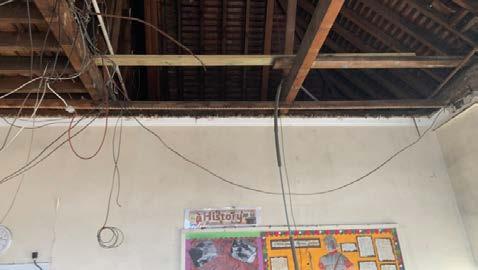
The Thurlow Educational Trust, which runs Rosemead Preparatory School in Dulwich, south London was fined £80,000 by the Health and Safety Executive after a ceiling collapsed onto 15 children in a Year 3 class, ITV reported.
Tables and chairs fell from an attic above the classroom injuring pupils and their teacher who suffered fractured limbs, cuts and concussions. Several pupils were taken to hospital for assessment and treatment following the incident which happened in November 2021.
Special educational needs group Witherslack Group is planning to open a school for primary and secondary pupils near Tonbridge in Kent, Kent Live reported. The company has applied to refurbish Mountains Country House in Hildenborough set in 28 acres of parkland, the former home of Fosse Bank School until it closed suddenly in March. The new school will cater for 90 pupils with SEN, aged between eight and 18.
The Welsh government says it intends to amend the current regulations governing independent schools in Wales in a bid to enhance the quality of education and improve the welfare, health and safety of independent school pupils, Herald Wales reported. The proposed amendments primarily focus on two sets of regulations: the Independent School Standards (Wales) Regulations 2003 and the Independent Schools (Provision of Information) (Wales) Regulations 2003. The Welsh government also intends to introduce a new set of Independent Schools (Prohibition on Participation in Management) (Wales)
Regulations, which outline the grounds for prohibiting certain individuals from participating in the management of independent schools.
The Edinburgh Academy has apologised for “brutal and unrestrained” historic abuse as the Scottish Child Abuse Inquiry took closing submissions in its investigation into the school, The National has reported.
Almost 50 witnesses have given evidence and 20 teaching staff at the school have been subject to allegations, including a child being beaten with a cricket bat, another pupil suffering a “small bleed on the brain”, a child being strangled, and boys being paid to swim naked. Most of evidence has covered the years between 1954 and 1995.
Corporal punishment was banned in Scottish private schools in 2000, but the hearing heard that “disproportionate sadistic violence” was common in the school in the 1970s and a “culture of fear” prevailed, with former teacher, Iain Wares, described by a lawyer for survivors as “one of the most prolific abusers in Scottish criminal history”.
The Edinburgh Academy acknowledged the “brutal and unrestrained” violence and admitted “serious sexual abuse was widespread”, and expressed regret that police were not brought in to deal with Wares in the 1970s. He was instead recommended to Fettes College. Wares and fellow teacher Hamish Dawson, who died in 2009, were publicly named during the inquiry. Wares was dismissed in 1979 and now lives in South Africa.
Courteney Donaldson reveals the secrets to owning your own school: How do you go about it? What are the risks? What are the opportunities?

It may sound a bit of a cliché but, for your school business to succeed, whether for-profit or not, you’ll need to have a genuine passion for what you’re doing. Successful business owners never underestimate the amount of work they’ll need to put in and the potential impact on their family and friends. It’s not enough to be acquiring or starting your own business because you are fed up with working for someone else, or because you are tempted by the idea of a millionaire lifestyle, albeit rare in education. You won’t get there unless you have the deep enthusiasm and drive which are necessary to succeed.
For many company directors, school proprietors and trustees, the decision to sell their school can be a difficult one. Typically, they will want to keep the sale highly confidential to mitigate any risks associated with the potential departure of staff and/or pupils, uncertain as to what the implications of a sale may mean to them as employees, or concerns from parents on the implication that a sale may have on their children’s education.
Because of the confidential nature of the independent school sales market, it’s essential that, alongside making web and press-based searches for possible acquisition opportunities, you work with an agent that specialises in the sale of education businesses. Concisely advise them of your specific requirements:
• What type of school are you looking for?
• Where?
• What operational profile?
• What capacity and tenure?
• One with an established track record or a turnaround?
Once the agent understands your strategy, they will be able to determine the opportunities currently available which are best suited to you. They are likely to ask you to sign a non-disclosure agreement prior to any sensitive information, such as management
accounts, being released to you. The agent’s role when acting for the vendor (business owner/trustees) is to introduce suitably vetted and serious prospective purchasers that have the prerequisite experience and financial ability to conclude a transaction successfully.
Ordinarily, most educational establishment acquirers will require bank or investor funding to finance their acquisition. First, speak to a financial broker that specialises in securing commercial mortgages for business acquisitions. This will ensure that your aspirations on the funding front are realistic from the outset.
Post-pandemic, and amid banks’ desire to mitigate risk, providing evidence of your educational experience and business acumen will be essential, and a comprehensive business plan will help to demonstrate this. Presenting both yourself and your business acquisition intentions and ideas in the best possible way to potential lenders is a vital part of securing any funding that you may need to acquire and invest in a business.
The agent’s primary objective is to achieve the best possible price for their client, often the vendor, and then subsequently support the transaction, from headline
deal terms and price being agreed, through to completion. Most acquisitions will be subject to financial, operational, property, and legal due diligence and, if a bank or lender is to provide a commercial business mortgage/loan, it’s likely that they will require a formal RICS ‘Red Book’ valuation for secured lending purposes, along with a building survey so that the condition of the asset can be assessed and any defects or requirements for capital expenditure identified.
Location: this is of prime importance to the success of a school and dictates the catchment areas from which students will predominantly come from. Think about demographics, competitors, local trading conditions, fee levels, average house prices in the area and so on. If you intend to be a hands-on proprietor, locality will be a matter of personal choice for you and your family. Also, consider the direction of travel for the school. If you’re contemplating growing boarding provision and seeking to serve international pupils, then ease of access to international airports, roads and rail will be key.
Tenure: does the school trade from freehold or leasehold premises? Think about both the long term and the short terms, how much money you can afford, loan serviceability and surplus for
“For many company directors, school proprietors and trustees, the decision to sell their school can be a difficult one.”Courteney Donaldson
reinvestment and any capital investment plans.
Property: consider the condition of the building and any repairs needed. If you are planning to acquire a school which has listed building status, do not underestimate the complexities and costs that ongoing regular maintenance and refurbishment may entail. Does the asset have scope for further development, or does it already benefit from purpose-built facilities which set it apart from other local competitors? Are sporting facilities held on the same legal title as the rest of the school campus, and, if they are leased or held on a licence, how secure are your rights as a buyer to occupy and use them?
Many factors determine the value of a school: its location, its buildings, their configuration and condition, the school’s tenure, its assets and liabilities, its fixtures and fittings, and goodwill. But the single most important factor associated with the value of a school when being sold as a going concern is its financial information. This comprises the business’s accounts, management accounts, cash flow forecasts, and profit and loss projections.
To be able to read your prospective school’s accounts, you need to have a good grasp of accounting principles, forecasting and business planning. A concise understanding of how the school is currently performing is essential, but the best way to look at accounts is to take as long a view as possible and to examine accounts from the previous few years. Good, dependable and accurate termly management information will be vital. You and your accountant will have to decide whether the accounts represent the true situation and, from there, you should be able to determine whether the business is well run, is overpriced given the level of current earnings, and/or if it has potential for a more efficient commercial operation or growth via changes or expansion.

You may be considering buying an independent school, developing a new SEND school or sixth form, selling or
transferring ownership of a school, or simply seeking to reflect the worth of your school in your accounts. In fact, any aspect of holding an interest in a property is likely to require a valuation at some stage. So, what aspects of the business form part of the valuation?
The calculations for the value of the school business will be based on the number of students in each year group, additional income, bursaries and so forth, and the valuer’s assessment of the sustainable level of occupancy or roll numbers. This will have regard to historic rolls and factors that might affect future rolls. The level of fees being charged will also be considered, as will the scope for fee increases and other potential revenuegenerating activities.
The four main categories for assessment are:
• Staffing
• Direct costs
• Premises costs
• Administration costs.
The end figure, or ‘market value’, includes the property, the fixtures and fittings and any goodwill attributable to the business. To calculate this, the level of operating profit is multiplied by the appropriate multiple, known as a ‘years purchase’ (YP) for that property. The YP is selected by benchmarking against comparable evidence from the sale or acquisition of other broadly comparable independent schools. This YP needs to be evaluated carefully to reflect the security of income streams, potential for growth or diminution in trade, the attributes or shortcomings of the school (and/or its assets), the strength of demand from purchasers/desirability of the business (and assets), location, availability of finance and potential serviceability of
loan/mortgage. The valuer will primarily have regard to transactions involving other broadly comparable schools. This evidence of actual sales is then interpreted in relation to the subject property.
Before you formally begin the process of buying an independent school, speak to a specialist business property advisor about the market so you have a good understanding of pricing, competition etc.
During 2022, the volume of operational independent school transactions was suppressed in comparison to previous years, primarily due to financial performances being largely distorted for the academic years 2021-22 postpandemic. Across the UK we saw an increase in smaller independent schools making the difficult decision to close and when those properties were presented to the market, a lot of interest came from SEND and specialist education providers.
The UK independent schools market continues to be highly fragmented and, therefore, opportunities for corporate groups and investors to acquire via portfolio buy and build strategies are not as prevalent when compared to the volume of opportunities in other operational real estate sectors. Established schools, with high rolls and a solid track record of stable and established earnings, continue to be highly sought after by buyers, as do smaller schools which may have closed but could be converted to a more specialist education use, or offer potential for alternative use.
Continually thinking about strategy is critical to your school’s consistent improvement. Leadership consultant Mike Buchanan argues, however, that you shouldn’t complicate your approach
As we have emerged from the immediate demands of the pandemic, many independent schools have been considering their futures in the face of a changed market for independent education, the ravages of unpredictable inflation and heightened threats from possible future changes to taxation and/or their charitable status.

I’ve been working with a number of schools and their leaders to help them think about those futures and to plan for them. Often, people rush to producing a detailed, often complex operational plan using SMART targets and other familiar paraphernalia. This seems to satisfy a need and they often look impressive, yet they often fester unread and unused once launched.
Distilling something simple which becomes a constant touchstone for actions, behaviours and standards is much more challenging and vastly more effective. The process of distilling is an essential element of a simple, effective strategic plan.
Plans have multiple audiences so you should be clear about who they are: staff, parents, children, governors, inspectors, the public. A well written plan can meet the needs of all without compromising the distinctive message and meaning you wish to convey.


Such a plan might have just three elements. Your challenge is to produce something on a single side of A4.
This is your three-minute pitch to prospective parents that encapsulates all that the school is about. It should use the language you use to reinforce these elements with staff and students every day. One of your measures of success is how quickly, loudly and often this language is parroted by others without prompting, and how everyone’s behaviours reflect these key elements. For example:
Learning: every child develops an understanding of themselves and their capabilities, and progresses to a school, university, college or employment of their choice with the confidence to take on their future.
Performing: every child achieves more than they ever thought possible, inside and outside the classroom, across a wide range of exacting intellectual and other pursuits, whatever their starting point.
Thriving: every child is happy; they are kind, principled, loyal, generous, determined, responsible, compassionate and bold; they relish collaboration, enjoy the intellectual freedom to be creative, the enterprise to act and the resilience to cope with adversity.
Here is where you can be clear about what you are expecting to see and feel in the school. Each of these elements is likely to have more detailed plans for delivery at sub-school level, providing accompanying
explanations of what they look like in practice and as measures of success. Your school may have a different number of elements in the ‘How do we do it?’ section, but I’d urge you to minimise these as this will force you to write with clarity and precision – every word must be carefully chosen to convey your specific meaning, and please do ruthlessly expunge all edu-jargon. Using plain English and active verbs will make it more powerful, lead to greater consistency of application, and make it accessible to all of your intended audiences, particularly parents.
Ensuring expert, supportive teaching, assessment and care for every child, and learning that is challenging, inspiring and leads to success.
Prizing individuality, connection and community, apparent in how we behave and include each other.
Providing a curriculum of powerful knowledge that is demanding, meaningful, nourishing and exciting.
“Distilling something simple which becomes a constant touchstone for actions, behaviours and standards is much more challenging and vastly more effective.”Mike Buchanan
Valuing curiosity and perseverance, and aiming to help each child to develop independence of mind and spirit.
Developing children who are eloquent, bold, relish responsibility and learn from taking measured risks. Ensuring the school is a great place to develop professionally and flourish personally.
Welcoming challenge and change as opportunities for growth; combining high trust and high accountability.
Enabling children to discover their creativity and abilities through exacting, varied physical, artistic, cultural and social activities.
Realising, recognising and rewarding the best from everyone and the best in everyone.
Expecting proactive, optimistic leadership and explicit modelling in every role and continually looking for improvement.

The final element of the three is how you will know when you are being successful and therefore need to re-plan. This is your opportunity to describe the sunny uplands that you are seeking. Your context will provide this. It may be that you are embarking on a significant period of change as you switch from being a predominantly boarding school to one more focused on the local day market, or that you are extending or collapsing your age range. It may be that you are seeking to evolve your already successful offer on the arrival of a new head or as you embark on a bursary campaign. This is where you can describe what success looks like so that your audiences are inspired by the possible and what is to come. It might be quite simple, for example:
Excellence in teaching, learning, assessment and care is our overarching focus; it drives our behaviours. Our prize is to be recognised for this, demonstrably to surpass the attainment for similar pupils in competitor schools, and to be the first choice of parents seeking an independent education in the area. The indicator of our success is delighted parents and growing demand for places because of the positive experiences of the children and their performance in exams and elsewhere.
The successful delivery of the plan involves four steps:
• Modelling behaviours, attitudes, language, relationships – bringing your values to daily life
• Building understanding of the plan and conviction through story-telling each day
• Building simple tools to enable people, weeding out obsolescence and removing blockages and blockers
• Developing skills, including risk-taking without fear of blame.
So a simple, touchstone plan on a single side of A4, written for multiple audiences in clear, compelling, plain English is the initial challenge. Bringing it to life will require more elaborate delivery plans at all levels in the school but, now, these plans can be created and evaluated against this touchstone strategy, and you can be holding people to account against the behaviours and attitudes encapsulated in your plan. Good luck.

It is well known that there are a huge number of economic pressures on the independent school sector. With inflation increasing the school cost base, as well as affecting the disposable income of our parents, with potential VAT imposition on the horizon and a relentless rise in interest rates since the end of 2021, there are plenty of issues to focus the attention of bursars nationwide.
A rising base rate is making borrowing more expensive for schools and creating a ‘mortgage payment time bomb’ for parents who are exiting longer-term fixed rates over the next 12 months.
One thing that hasn’t kept up with the pace of the increase in bank rates is the return offered by banks on their deposit accounts.
Banks partly rely on lethargy among their customers. It’s often claimed that you are more likely to get divorced than change your bank account. Add to that the difficulty faced when trying to search for banks that take deposits from schools and then actually trying to open an account, it’s not difficult to see that there’s no real incentive for the ‘Big Four’ to increase their deposit rates at the same pace as their borrowing rates.
A significant amount of income a bank makes is generated by rate margin – the difference in rates at which they lend money compared to the rates they pay
for deposits. As rates have increased, the opportunity for banks to grow that margin has increased.
Schools with healthy reserves will often trust their long-term investments to a fund manager, often shorter-term cash reserves and operational cash are left without much focus.

Short-term cash reserves and operational cash can be quite sizable. If we take an example of a school generating £7.5 million a year in fee income (collecting fees at the start of each term), its cash flow could look something like the graph below:

This leaves a significant amount of cash sitting in a current account, probably earning close to zero.
Having worked in the banking sector for 35 years, focusing on the education and not-for-profit sectors for the last 20, I have supported hundreds of independent schools and academies in reviews of their
deposit strategy with a view to increasing significantly the amount of interest generated for their money. The past year has seen a significant growth in appetite from schools hoping to maximise returns as the bank rate has risen.
A deposit platform is a technological offering to overcome the need to produce an ID and address verification while completing an application form each time you want to open a deposit account. The platform provider verifies the school and its chosen signatories and then allows the school to open deposit accounts with a multitude of banks directly from a single, online platform.
With the increased use of deposit platforms, hundreds of schools have removed the biggest barrier to shopping around as the school is free to use the
platform to open new accounts at will, alongside using its existing accounts. You will often find that banks offer an enhanced rate of interest for accounts opened through one of these platforms compared to going directly to the bank. The reason for this can be twofold. First, it is a ‘low cost to serve’ method for the bank to collect deposits. After all, there’s no need for the services of a relationship manager or a branch, so deposits can be managed at lower costs. In addition to this, banks know that someone considering a deposit platform is looking for a competitive rate so they will often put their most competitive rates through the deposit platform, knowing that the majority of their existing clients are unlikely to be exploring these higher paying options.
While deposit platforms have been used in the UK for many years by companies and individuals, they are a relatively new consideration for the school sector. If this is an area you would like to explore, here are several questions to be considered:
1. Does your investment policy cover short-term cash deposits? If it doesn’t, then you should consider creating one. A policy should be specific and not open to wider interpretation, giving you clear guidance on the type of institution you can place deposits with.
2. What happens if the deposit platform goes bust? Make sure the platform you use holds your funds in accounts in your name or as client accounts (much like a solicitor’s client account), ensuring that the funds are yours and that any liquidator could not use them if they need to wind the company down.
3. Security of withdrawals and deposits. It makes sense to choose a platform that allows you to stipulate ‘dual control', that is, two people authenticate each transaction.
4. Which banks should I choose to place deposits with on a platform? Your
investment policy for cash deposits needs to stipulate the criteria in place for you to place funds (for example, jurisdiction, credit ratings etc).
5. Is it financially worthwhile? As at 30 June 2023, some instant access accounts were paying over 3% and some 12-month fixed rate deposits were paying around 6.5%. If these rates remain unchanged for a year and you kept a deposit of £1 million in them, this would give you an indicative return of somewhere between £30,000 and £65,000 over a year.
A selection of interest rates from a variety of banks on one deposit platform is detailed below. These rates were correct on 30 June 2023 and the indicative returns* assume that rates do not change and funds are left for a full year at these rates.
For any school with an element of surplus cash, it makes sense to explore a wider range of deposit options to help offset some of the cost pressures that are being experienced now as well as those on the horizon.
Next Steps:
1. Review your cash flow forecasts to understand your level of cash for potential deposits.
2. Ensure you have a robust investment policy that covers cash deposits.
3. Consider a deposit platform to help you maximise your deposit interest earned while minimising the administration of account opening and management.
Ian Buss runs the consultancy Education Banking Support – linkedin.com/in/ianbuss
“Banks partly rely on lethargy among their customers. It’s often claimed that you are more likely to get divorced than change your bank account.”
In the first of a series of three features, Nigel Aylwin-Foster outlines how to plan the decarbonisation of your school estate

Five years ago, I doubt the term ‘EDP’ had ever have been heard of in the independent education sector: it stands for ‘Estate Decarbonisation Plan’. Now, with the marked increase in focus on becoming net zero within the UK, not least in the education sector, the EDP has become an important planning tool for schools. Every school will need one, and staff must understand what it is and why it matters. It’s not a long-shot to suggest that within the next five years every school in the sector will have developed one, even if the school doesn’t intend to implement the plan for several more years. After all, even if the intent is to leave an action until the last safe moment, without a plan, how does one know what the last safe moment is?
This article will explain the Why? and the What? The two subsequent articles will look at the How? in more detail.
Being net zero carbon means ceasing to use or rely on fossil fuels for any part of the school operation, including in the supply chain and off the estate (for example, staff commuting and school trips on commercial transport), or offsetting where the irreducible minimum of fossil fuel usage has been reached. Estate decarbonisation therefore means ceasing to use or rely on fossil fuels for the operation of the school estate – in essence, for all the estate’s heat, transport and power requirements. Notwithstanding the challenges, all schools in the UK should eventually be able to achieve this, although it will take time, money, effort and appropriate prioritisation.
“Developing an EDP is the work of some months of study, culminating in the production of the plan.”
The purpose of an EDP is to describe how a school intends to achieve this. This needs to be worked out in enough detail to determine a programme for implementation, along with the management, resourcing and budgeting requirements. The latter is important, so that the school can invest accordingly to its broader development plans.
In most cases, the resulting programme of decarbonisation will last at least a decade, probably two. The EDP will inevitably require some adjustment en route to the school achieving net zero carbon, but that does not negate the worth of drawing one up in the first place.
Developing an EDP is the work of some months of study, culminating in the production of the plan. Undertaken with the necessary engineering and commercial rigour – and with a keen eye on pragmatism and practicality in an educational setting – the task is akin to crafting an estate master plan, except that the subject matter is mechanical and electrical rather than an exercise in managing the time frames for when to build.
A well-crafted EDP will:
• Take account of the school’s current situation and general development plans, both in the physical and broader educational sense
• Provide an update on the political, legislative and commercial context of the work. These all have some bearing on the decarbonisation options
• Provide a clear description of the opportunities, costs, timescales and impact of the full range of decarbonisation work required on the estate, with supporting technical, engineering, and commercial logic. This includes the scope for improving energy efficiency on the estate, so that less energy is required in the first place, as well as the scope for the conversion of the estate’s energy systems to alternative low-carbon technologies
• Provide preliminary scopes of work and design concepts for the more complex infrastructure projects, largely driven by conversion of the heating plant and the changes to the power infrastructure required to support the heating plant conversion. (Note that conversion of the heating plant will almost always be the most challenging and expensive project within the plan. Even though, in some cases, it could be a decade or more before the fossil fuel heating plant needs to be phased out, it’s not feasible to estimate the conversion costs realistically without drawing up at least a preliminary design concept. This matters, because the costs are such that they are almost bound to require some significant changes to the school’s existing development plans: it’s in a school’s interests to understand the potential impact sooner rather than later)
• Take account of the interactions between the various technologies involved, to produce an integrated design concept for the use and development of heat, transport and power systems across the estate.
• Produce a cost/benefit analysis for each major project enshrined in the plan, including an estimate of the reduction in greenhouse gas emissions and potential reduction in operating costs
• Provide metrics to measure year-on-year progress, with reductions in energy usage and carbon emissions
• Set out a year-by-year implementation programme for all the major energy efficiency and decarbonisation projects, including annual estimates for the required capital outlay. The work can then be incorporated into the broader estate development plan, so that funds can be raised and allocated in a timely fashion and projects can be executed in good order when required, rather than being rushed. Low-carbon conversion projects in schools do not respond well to being rushed, especially the core business of converting the school’s heating.
• Advise on the immediate next steps required to start turning the EDP into action.
The terms ‘sustainability’ and ‘net zero’ often seem to be used interchangeably, but in practice they are not synonymous and it’s worth being clear about the interrelationship. Both will come to matter more and more in schools, and resources need to be targeted with a clear sense of purpose.
Environmental sustainability encompasses everything from reducing emissions to encouraging biodiversity, reducing the extinction of species and even investing sustainably. The most commonly used agenda for this in the independent education sector is the UN’s 17 Sustainable Development Goals shown below:

We’ve already discussed the purpose of net zero carbon, but there’s now another net zero on the block – net zero for energy. Being net zero for energy means a school generates as much energy as it uses, even though it may still need to buy energy from external sources. This is not the same as being net zero carbon – a school could in due course become net zero carbon but still be heavily reliant on the procurement of energy from external sources. In contrast, a school could be net zero for energy but still not be net zero carbon. The distinction between the two is somewhat nuanced but it’s important to be clear about the school’s priorities before an EDP is developed because it will influence the development of the plan. Net zero carbon is ultimately about reducing the impact of climate change; net zero for energy is motivated by the desire to reduce operating costs.
The Venn diagram below illustrates the interrelationship between these three purposes, within a school context:
As already outlined, all schools in the UK should be able to achieve net zero carbon (given time, money and effort) whereas most schools in the UK will not be able to achieve net zero for energy, simply because they lack the real estate to be able to install the required onsite power generation and storage systems. However, they will still be able to get part of the way and it will remain a worthwhile goal.
In the two next editions, I’ll outline how to plan for these respective net zero goals.
“The terms ‘sustainability’ and ‘net zero’ often seem to be used interchangeably, but in practice they are not synonymous and it’s worth being clear about the interrelationship.”
John Fraser considers how the threats of climate change should affect your approach to managing risk in your school estate

In 2020, the earth’s surface temperature was 0.98oC warmer than the 20th century average. December 2021 saw 12.2 million square kilometres of sea ice adrift in the Northern hemisphere, a 4% increase from the previous year. Our climate is changing and, regardless of where your school is located in the UK, this is likely to have a significant impact on your property risks. Increased rainfall and flooding, drought and heatwaves, and extreme weather events are climate-change challenges that will all require risk mitigation.
Climate change has led to an increase in the frequency and severity of floods and rainfall in the UK. This poses a significant risk to all schools, not just those located in flood-prone areas, increasing the likelihood of damage and the cost of insurance premiums. In particular, heavy downpours can overwhelm drainage systems and cause flash flooding in schools. This increase in surface water runoff poses challenges for drainage, including sewers and surface water management systems. These systems may become overwhelmed, leading to localised flooding, sewer backups, and increased risks to properties.
The increased rainfall intensity and the risk of flooding associated with climate change can pose a threat to school buildings located in flood-prone areas. Flooding can result in structural damage, damage to equipment and resources, and
the disruption of educational activities. Schools may need to implement flood mitigation measures, improve drainage systems, or consider relocation in extreme cases.
Climate change has also contributed to more frequent heatwaves and drought conditions in the UK. Higher temperatures and prolonged dry spells can affect school buildings and infrastructure, leading to issues such as subsidence, structural damage and increased fire risks. During periods of drought, soil moisture levels decrease, causing the soil to shrink. This shrinkage can result in subsidence, particularly in areas with clay soils that are highly sensitive to moisture changes. Additionally, extreme heat can affect the wellbeing of staff and pupils, increasing cooling demands and affect future energy costs.
Rising temperatures can create uncomfortable and potentially unsafe conditions for pupils and staff, particularly in schools without adequate cooling systems. Heatwaves can affect concentration, physical wellbeing and productivity. Schools may need to invest in cooling measures or adapt their schedules to mitigate the impact of heat stress.
The UK has experienced an increase in severe storms and extreme weather events as a result of climate change. These storms, coastal storm surges, intense hailstorms, high wind speeds and wildfires can all cause significant damage to properties, including roof and solar panel damage, flooding and structural issues. Such events can lead to higher insurance premiums and increased costs of property maintenance and repair.
Schools may face disruptions in their operations due to school closures, power outages, or damage to infrastructure
caused by severe weather events. This can affect the learning environment and potentially lead to the temporary closure of part or all of a school.
Climate change can also worsen air quality, particularly in urban areas. Increased pollution and higher pollen levels can affect the health of pupils and staff, leading to respiratory issues and reduced wellbeing. Schools may need to implement measures to monitor and improve indoor air quality, such as proper ventilation systems and filtration.
It remains crucial for schools to stay informed about climate change impacts and take appropriate measures to protect properties and manage associated risks.
Schools may need to consider retrofitting existing buildings to improve energy efficiency, adapt to changing climate conditions, and reduce their carbon footprint. This can include upgrades such as insulation, energyefficient lighting, renewable energy installations, and rainwater harvesting systems. Such measures can enhance the sustainability and resilience of school infrastructure.
Climate change and the associated risks can also have psychological and emotional impacts on pupils, staff and the
“The increased rainfall intensity and the risk of flooding associated with climate change can pose a threat to school buildings located in flood-prone areas.”John Fraser
school community. Concerns about the future, eco-anxiety and a sense of urgency may affect mental health. Schools can play a vital role in providing support systems, promoting climate literacy, and fostering a sense of empowerment and resilience in the face of climate change challenges.
It's important for schools to engage in climate change adaptation planning, assess vulnerabilities, and develop strategies to manage and respond to the effects. Collaborating with local authorities, educators and the wider community can help ensure a comprehensive and coordinated approach to address climate change impacts on schools. Remember to:
• Stay informed: stay up to date on how climate change affects your region specifically. Understand the potential risks, such as flooding, coastal erosion or extreme weather events that your school may face due to climate change.
• Assess vulnerabilities: conduct a thorough assessment of your property’s vulnerabilities to climate-related risks. Identify areas that are at higher risk, such as cellars, low-lying areas, or locations near water bodies. This assessment will help you prioritise risk management efforts and take appropriate actions.
• Be insured: speak to your insurance broker to review your coverage to ensure it adequately protects your property against climate-related risks. Understand the terms, exclusions and limitations of your policy. Consider additional coverage options, such as flood insurance, to enhance protection. Regularly review and update your insurance coverage as needed.
• Maintain and upgrade property: regularly maintain your property to ensure it is in good condition and resilient to climate-related risks. This may include maintaining drainage systems and gutters, inspecting and repairing roofs, reinforcing vulnerable structures, and protecting against wind and water damage. Consider
For schools with Grade I and Grade II listed buildings, the risks driven by the effects of climate change are likely to be higher when compared to other buildings. Factors such as location, specific construction materials and methods, previous maintenance, and ongoing conservation efforts can influence their vulnerability. Engaging with conservation professionals, architects and heritage organisations can provide valuable guidance on assessing and managing climate change risks specific to these buildings while preserving their historical significance. Things to consider:
• Age and vulnerability: a listed building’s age and construction methods can make it more susceptible to damage from floods, storms, wildfires, and other climate-related hazards.
• Limited adaptability: listed buildings are subject to preservation regulations that limit alterations to their original fabric and appearance. This can restrict the implementation of modern retrofitting and adaptation measures that could enhance their resilience to climate change effects.
• Location and exposure: Grade I and Grade II listed buildings are often located in areas with historical significance, such as city centres or near water bodies. These locations may expose them to other indirect climate-related risks, such as air pollution or flooding.
• Maintenance challenges: listed buildings require careful maintenance to preserve their heritage value. Climate change impacts, such as increased humidity, higher temperatures, and more frequent extreme weather events, can accelerate the deterioration of building materials. Maintenance and repair costs for these buildings may increase as a result. In addition, the specialist skills to perform the maintenance – such as stonemasons – maybe in short supply increasing costs and lengthening timelines.
energy-efficient upgrades that enhance climate resilience, such as insulation, storm windows or renewable energy installations.
• Ensure sustainable drainage: implement sustainable drainage solutions, such as rainwater harvesting, permeable paving, or green roofs. These measures can help manage storm water runoff, reduce flood risk, and contribute to the overall sustainability of your school.
• Landscape and plant vegetation: utilise landscaping techniques that enhance climate resilience. Planting native vegetation, creating more green spaces, and implementing appropriate irrigation systems can help manage soil moisture, reduce erosion, and mitigate the effects of extreme temperatures.
• Have an adaptation and resilience plan: develop a climate adaptation and resilience plan for your school which
should include strategies to address identified risks and potential future scenarios.
• Engage with the local community: collaborate with your neighbours, community groups and local authorities to implement neighbourhood-level resilience measures, share information, and support each other in managing climate-related risks.
• Develop financial planning: incorporate climate-related risks into your long-term financial planning. By implementing an appropriate blend of these risk management strategies, schools can enhance the resilience of their properties and operations and reduce the potential effects of climate change.
John Fraser is managing director of the education practice at insurance broker and risk advisor Marsh.
The planning of maintenance regimes and their associated costs have always been important for independent schools. However, rather than simply maintaining the condition of the estate, schools should now be looking to incorporate planned maintenance works alongside opportunities to improve the energy performance of their buildings too. This will help them reach their ambition of being environmentally sustainable enterprises.
To help maintain school buildings in good condition, planned preventative maintenance programmes should be used to help forecast key moments of expenditure in a manageable way. This sets out which building fabric, mechanical and electrical items require replacement and remedial works over the next five to ten years and helps to identify periods of greater expenditure required to maintain the functionality of the buildings.
Independent schools are also now trying to improve the operational efficiency of their buildings to become more sustainable and with a lower carbon footprint.
Ongoing maintenance requirements and the aspiration to improve the operational efficiency of an estate do not exist in isolation and should be considered together as a single exercise when forecasting budgets for capital expenditure.

Planning for cyclical maintenance should be considered as part of a wider strategy that reviews opportunities for either upgrading or installing new building fabric elements and mechanical systems. Most importantly, this will help target expenditure where it will make the most difference and prevent expenditure on items that may be superseded with later refurbishment or upgrade works.
There are a number of ways to reduce operational carbon and improve the efficiency of school buildings. Often, the choice of the primary energy source of the building has a significant impact on this.
The use of gas or oil-fired boilers in buildings is a carbon intensive energy source. Switching to modern electric heating options, such as electric boilers or variable refrigerant flow systems, can reduce the carbon footprint of a building. The CO2 emissions associated with grid supplied electricity have significantly reduced in recent years due to greater renewable technologies being incorporated onto the grid system, which has also moved away from reliance on fossil fuel-based power such as coal.
While there are other mechanical and electrical installations that can be used to improve performance, such as the installation of photovoltaics and LED lighting, there are also options to make improvements to building fabric elements. These building fabric options include reviewing the levels of insulation within ceiling voids and cavity walls and the glazing to windows. Upgrades to existing insulation to comply with the U-values for roofs and cavity walls as set out in the updated Approved Document Part L published last year could see a reduction in heating requirements. Additionally, installing new double or triple glazed windows could reduce heating requirements by increasing the air tightness of a building, but should not reduce useful ventilation of the building as discussed in Approved Document Part F.
The benefit of each potential improvement option should be considered as part of a modelling exercise. This exercise is usually undertaken in producing an Energy Performance Certificate, which despite only being a legal requirement in certain circumstances, may be useful in understanding the most effective options for reducing the operational carbon footprint of a building.
Understanding and capturing the operational efficiency of a building is essential to mapping out any potential improvement works. A way to do this is through the use of Energy Performance Certificates (EPCs) and Display Energy Certificates (DECs).
EPCs provide a rating for the modelled energy performance of a building based on its construction and specification. The Minimum Energy Efficiency Standards currently require a minimum E-rated EPC to be produced for the construction, sale and letting of non-domestic private rented properties.
While EPCs can be considered an imperfect tool, in the absence of anything else they can still provide a useful benchmark rating (from A to G) indicating the modelled energy efficiency of a building.
Alternatively, DECs measure the actual energy performance of a building by taking into consideration how a building
“Independent schools are also now trying to improve the operational efficiency of their buildings to become more sustainable and with a lower carbon footprint.”Richard Fitz-Hugh
is used over a 12-month period. DECs are required to be displayed in buildings over 250 square metres that are occupied by public authorities and frequently visited by the public. While independent schools might not fall into this category, DECs are nonetheless another useful benchmark to demonstrate the operational efficiency of a building.
Despite the upfront capital expenditure associated with undertaking upgrading works, there is the potential to achieve a reduction in primary energy use in the long term, that is, the primary loads such as lighting, heating, ventilation and air conditioning.
Modelling exercises carried out to consider the effects of various installations on an EPC rating can also indicate the corresponding effect on primary energy use for the building for each installation or combination of installations, that is, electric boiler, photovoltaic panels etc. While this is a simulated scenario with certain assumptions on daily usage, occupancy
rates etc, it helps identify the potential reduction in running costs of a building with those particular installations.
An understanding on potential longterm reduction in running costs may help inform decision-making on short and medium term capital expenditure.

Understanding the condition of existing building fabric and mechanical and electrical systems, their maintenance requirements, their effect on the operational efficiency of a building and the scope for altering and improving those elements requires careful consideration.
Undertaking refurbishment works to buildings is often not a straightforward task. For example, removing a gas-fired heating system and replacing it with a new VRF system may require a feasibility study that considers the physical space required for pipework routes and external plant, the timing of works around school term dates, and any statutory requirements for planning permission. It may also be that an upgrade to the
building’s existing electrical power supply is needed – and the ability to do this may depend on wider electricity supply network capacity.
Additionally, many independent schools comprise listed buildings that can be more challenging to adapt and alter. Technical challenges arise in installing the new installations while ensuring minimal impact to the original features of the building. In most cases, a listed building consent application will need to be submitted to the local authority.
Considering these challenges and the ways to improve the operational efficiency of a building should be done alongside a traditional planned preventative maintenance programme. Reducing carbon emissions of a property portfolio is becoming an increasingly important task and should be considered alongside basic maintenance requirements to ensure a joined up approach to estimating capital expenditure requirements.
Heather Lamont says responsible investment is about sustainability, not compromise

Ethical investment? Responsible investment? ESG? Sustainability? Impact investing? If you’ve been discussing your school’s investment policy recently, no doubt some of this jargon will have crept into the debate. But when the industry can’t even agree what to call it, never mind what it means, it’s no wonder there’s a good deal of scepticism around. Many an investment committee will be inclined to reject any reference to non-financial issues as a marketing gimmick which risks detracting from spending resources.
However, ignoring the subject isn’t really an option – at least not if you want to comply with investment guidance from the Charity Commission and other regulators. The good news is, it shouldn’t actually be that difficult to understand and agree on what’s important (and what’s not) for your school and how to express your priorities in your investment policy.
A straightforward framework for thinking about the non-financial aspects of your policy typically encompasses three distinct, but often overlapping, approaches.
The longest established and most traditional approach, as well as the easiest to implement, is what most people would historically have meant by ‘ethical investment’. It’s principally about identifying any types of business activity that you don’t want to see among the companies in your portfolio because
they conflict with your school’s values or would expose you to reputational risk.
For some schools a light touch will be sufficient and appropriate here, indeed many parents and governors will be content if there are no explicit exclusions. It’s perfectly legitimate to conclude that you don’t need an ethical policy, but you should still have the conversation and record your rationale. Conversely, many investors, including most faith schools, will want their investment policy to reflect their founding ethos, and they will often be able to refer to faith-consistent investment guidance specific to their own institution or denomination for help in expressing their policy.
It’s important to work with your fund manager to understand how they will implement your intended policy. Do they have the information resource to identify and monitor which companies may fall foul of the agreed policy? What revenue thresholds can they apply when screening for excluded stocks? A typical approach is to exclude any business which generates more than a given percentage (often 10%) of its turnover from the offending activity. This works well for most themes, for example if you want to exclude tobacco companies but not supermarkets, a 10% screen for tobacco would usually do the trick. But there may be activities for which a zero tolerance is preferred; this is often the case in respect of illegal weaponry such as cluster bombs and landmines.
One common pitfall is to apply any exclusion policy only to ‘direct holdings’ in individual company names. In practice almost all schools’ portfolios are invested significantly, in many cases wholly, through pooled investment funds. If you do have exclusion criteria, you should discuss with your fund manager whether these are being applied consistently across the portfolio, and identify any reputational risk that you face if pooled funds are not screened according to the same criteria as direct holdings.
Incidentally, there’s no evidence that any reasonable screening policy need be damaging to your long-term investment
returns. Over shorter time periods there can be some divergence – this can be positive as well as negative – between screened and unscreened portfolios, but these variances tend to even each other out over time. In any case, the regulator is clear that charity trustees should at least consider whether any screening is appropriate for their organisation, not just dismiss the idea out of hand.
This is a key element of responsible investment management. Your fund manager should assess the risks to your portfolio associated with the environmental, social and governance (ESG) standards of investee companies and potential holdings. Unlike the ‘alignment’ approach above, this isn’t about what business they’re in, but rather about how they do business.
Good fund managers will address these issues as an integral part of their investment process, because this assessment is about enhancing the sustainability of your portfolio returns. However attractive they may look through the lens of conventional financial analysis, companies which have poor standards of behaviour tend to underperform over the long term. They are also more prone to financial shocks and sudden reputational damage which can destroy shareholder value. So your investment policy should recognise the
“Many an investment committee will be inclined to reject any reference to non-financial issues as a marketing gimmick which risks detracting from spending resources.”
importance of ESG considerations and your fund manager should be happy to discuss how they incorporate these in decision-making.

Schools and other charitable investors are increasingly aware that investment markets and portfolios can only be as healthy as the environment and
communities in which they operate. For many, therefore, the long-term sustainability of returns requires realworld change to help address systemic challenges like climate change, modern slavery and health crises such as soaring global rates of obesity and poor mental health.
A number of industry-led initiatives have already demonstrated that commitment and collaboration by investment managers who engage with companies and regulators on behalf of the investment community can indeed drive change in company behaviour over time. In practical terms, driving improvements in behaviour across the corporate sector has much more impact on the issues of concern than any policy on what sort of companies are or are not permitted in a school’s portfolio. Most investment decisions simply involve your school buying assets from other investors or selling to them. These transactions don’t change the amount of
capital that is allocated to the activities in question, whether ‘bad’ or ‘good’. Even policies which aspire to include ‘positive’ investments in the portfolio tend to have very limited real-world impact.
So another question for your fund manager should be around their commitment to driving real change on these systemic issues, and what impact they are having.
Which of these approaches – it could be one, two or all three of them – is relevant to your school? That’s the conversation you should be having, if you haven’t already. It doesn’t even matter what you call it. The important thing is to get past the jargon, consider what matters to your school and understand how your fund manager can support those objectives – and then hold them to account for delivering against what you’ve agreed.
“Schools and other charitable investors are increasingly aware that investment markets and portfolios can only be as healthy as the environment and communities in which they operate.”

Banish from your minds the phrase ‘terms and conditions’, which may evoke the impenetrable language of the ‘small print’, which is meant to be seen but not read. Consider instead that your parent contract is your script, your guide, your toolkit for shaping your business and the relationships on which it is built and on which it relies. It should say what you do and by doing what it says you should be best placed for success. From a tick box on a to-do list, elevate the parent contract to its rightful place as a priority, and a worthy investment of your time. Read on to remind yourself what the parent contract is and what it can do for your school.
A school’s existence is a matter of registration and regulation, but educational services are provided by independent schools through a private legally enforceable relationship with parents of pupils – this is the ‘parent contract’. It is no exaggeration to say that it is this legal relationship which is the foundation of your business. It bears weight in securing the health and future of your business and optimal outcomes for your beneficiaries, regardless of corporate/organisational structure.
It's a contract with individuals, not with businesses – a ‘consumer contract’, and as such it must also deliver a fair deal for the parent and be drafted in plain and
accessible language. Statutory protections for consumers must be accounted for and often cannot be compromised.
It’s also, at its core, an agreement between a school and parents, where schools promise to provide services to parents and their child, and the parents agree to pay for them. Beyond that, there’s so much complexity the parent contract must navigate in the pupil and parent relationship dynamics, the regulatory and legal framework which governs education, and the broad and variable nature of services provided by schools. The circumstances of the pandemic illustrated well that the utility of what schools do is in deliverable benefit rather than a list of facilities and services which can be separated and individually quantified. All this means that what you do defies simple definition, and the contract should be carefully written to reflect this to best effect.
It’s a contract and so must create a legally binding commitment between parties based on a mutual understanding of expectations, rights and obligations. It’s not just a set of terms and conditions. Your onboarding process and paperwork, and your marketing materials are all part of forming that binding commitment and determining the precise nature of it.
Broadly speaking, the terms of this relationship should address and support the fulfilment of the aims and expectations of the parties. For example, parents generally want high-quality education which they consider is suited to them and their child. Schools will each have their aims but will include delivering high-quality services through a sustainable business model. For parents, this is a question of finding the right school, fulfilling their financial and other commitments to the school, and holding it to account where applicable. For schools this will involve far more, including:
• Creating the space, tools and foundations to deliver a high-quality pupil-centred experience
• Establishing the basis for healthy and productive relationships with parents
• Delivering a fiscally healthy business and protecting the interests of stakeholders and beneficiaries
• Legal compliance and
• Risk management.
Your contract should provide what you need to meet the legitimate expectations of your market, to be competitive, and to deliver the school’s aims.
Your business is education and pupils are at the centre of what you do. The contract can create the footing for a pupil-focused service and space by providing a legally binding foundation for the school’s offer, professional judgement and authority. It can articulate and so embody and enable the school’s personality and mission and help shape the day-to-day experience of pupils and staff.
To succeed, the contract must be compatible with policy. It should also be clear and practical so that it can be understood by all concerned and implemented effectively. It is good practice both to maintain your contractual paperwork but also to train staff to use it. A good parent contract will give teeth to policy aimed at securing a safe and suitable environment for pupils and securing their welfare, including by providing the footing for robust pupil welfare risk management and discipline.
“It's a contract with individuals, not with businesses – a ‘consumer contract’, and as such it must also deliver a fair deal for the parent and be drafted in plain and accessible language.”

As the basis for your relationship, the contract has an important role to play in setting the expectations and boundaries needed for a healthy working relationship. It can achieve this by giving clear direction on what parents can expect, including reporting and information sharing, where there are conflicting rights and which will prevail, and providing you with the tools to secure parental cooperation and deal with unreasonable conduct.
While the aim is to establish and maintain good relationships, it can cause considerable disruption where a relationship is breaking down. Your contract should support you to deal with issues effectively, minimise disruption, and to end a failed relationship.
Fee income is the primary source of income for most independent schools and in many cases also funds bursaries and scholarships. Strong cash flow is
important and effective credit control relies on a clear and enforceable contract with fee payers. The contact should set clear terms for the payment of all fees and extras and provide suitable means of redress for late payment to support effective credit control (typically this will be fee-related exclusion, late payment interest and recovery cost indemnity).
The ability to plan effectively is key. The contract should provide clarity over notice obligations, so that you can accurately predict pupil numbers and plan accordingly. Equally important is the duration of the contract and you should consider carefully how you address this. Certainty has its benefits, but fixing the contractual term can create unintended risk, such as where a school has to close. Where the parent contract has a fixed term, which would typically be until the end of the school’s provision, the closure of the school would likely place the school in breach of contract and expose it to the risk of claims. Such a term could also possibly bolster a parent’s claim for damages if the contract was brought to an end by the school early following exclusion/required removal, as they may rely on the fixed term in order to quantify their loss.
The contract itself must be legally compliant. Consumer rights legislation is key, as it will place specific obligations on the school and limit those you can lawfully impose upon parents. The contract must at least be compatible with the school’s wider legal obligations including with family, equality and
information law, but it can also facilitate compliance, for example, by imposing obligations upon parents to disclose material information.
A contract which is up to date with the law and supports wider compliance, will help to manage the risks of legal non-compliance which can give rise to complaints, claims, regulatory action, and sometimes even criminal sanctions.
The contract can also help to manage risk by:
• Facilitating effective ‘know your customer’ practices
• Avoiding disputes through effective relationship management
• Setting parameters of the school’s duty and liabilities
• Imposing obligations of disclosure of material information (for example, family court orders, sources of income and wealth and immigration status)
• Providing a means of ending broken, damaging or disruptive relationships, and
• Providing contractual support to manage pupil welfare risks.
The parent contract is a vital tool of your business and worth your time. In these times of technological, social and political change, and a cost of living crisis, it’s crucial that it is working as hard as it can for you to secure your business now and long into the future. Is yours?
James Garside is a partner at law firm VWV.
“It is good practice both to maintain your contractual paperwork but also to train staff to use it.”
Most boards should have benefitted from a briefing on the new inspection framework from their executive; if you haven’t done so, make sure that the clerk ensures one is in place for this autumn’s term. Any sense of security engendered by the school having recently undergone an inspection under the previous framework is misplaced; any school can be subject to an additional inspection – announced or unannounced – at any time and schools will want to be up to date in terms of inspection documentation should such a visit occur.
One of the key changes in the new framework is that there will be no oneword qualitative judgements in reports – ironically something heads and teachers in maintained schools have been calling for in Ofsted inspections, especially since the death of Ruth Perry after the inspection of Caversham Primary School. Long-standing governors will recall that governance itself used to be judged, initially on a seven-point scale, later on a four-point scale, but under the framework now coming to an end, governance only featured in reports if it was deemed to be a contributory factor to pupil outcomes in terms of their achievements or personal development. Under the new framework,
although governance will not receive a judgement label as such, it will feature prominently owing to the prime focus of the new regime. In paragraph 16 of the framework, this is clearly set out: “the framework places the responsibility of the school’s leadership and management and governance to actively promote the wellbeing of pupils at the centre of the Independent School Inspectorate’s (ISI) evaluation of the school.”
It is claimed, and probably intended, that as this is already required under Standard 8 of the Independent School Standards Regulations (ISSRs), “this approach does not place any additional responsibility on schools or introduce additional requirements not already contained in the Standards’ (framework paragraph 19).”
This is probably disingenuous as there will be at least an expectation of extensive evidence demonstrating how this is done, as we shall see.
ISI has undertaken an extensive consultation since the publication of the draft framework last year, and this has led to some changes to the final version. The most important for governors is perhaps the confirmation of the understanding of the distinction between the differing roles and functions of governance and leadership/management, which had been ambiguous in the first draft. It remains the case that governors are expected to oversee and monitor the school executive, but not to interfere in day-to-day management of the school. It also remains the case that the ISSRs require the proprietor to ensure the effective implementation of appropriate policies and, as the buck stops with the proprietor (usually the governing body), that oversight and monitoring is expected to be robust and demonstrable.
There have been other amendments in light of the consultation although not
all the objections raised were accepted. Reports will begin with summary findings, and the first section will be on “leadership and management, and governance”, the strategically placed comma confirming that these functions are not conflated. Greater prominence has been given to “education, training and recreation”, now forming the second substantive section, one where the lack of a qualitative judgement may be most missed. The proposed separate sections on pupils’ social and economic education and pupils’ contribution to society have been combined into one section on pupils’ social and economic education and contribution to society (including careers). These areas are all usually well established in schools but governors will want to know where responsibility for them lies and how senior leaders will report on outcomes in this area. The final section of the report will be on safeguarding (no longer “protection of pupils from harm and neglect”. The other (third) section remains pupils’ physical and mental health and emotional wellbeing. No references will now be made to “serious causes for concern”, a probably welcome adjustment in light of the issues surrounding the Ofsted report on Caversham Primary School. And none will be made to “exceptional practice”, although we are promised nuanced reporting to include references, where appropriate, to “significant strengths” – I

“The most important for governors is perhaps the confirmation of the understanding of the distinction between the differing roles and functions of governance and leadership/management, which had been ambiguous in the first draft.”
foresee some disagreements where none are identified in ostensibly successful schools.
We have already seen that the framework emphasises the importance of Standard 8 of the ISSRs. Many governors have found it difficult to agree exactly how to approach this one and the advent of a new framework provides a good opportunity to discuss this with the executive. Paragraph 17 of the framework reminds people that: “Part 8 of the ISSRs places a duty on the proprietor to ensure that persons with leadership and management responsibility at the school: demonstrate good skills and knowledge appropriate to their role so the Standards are met consistently; fulfil their responsibilities effectively so that the Standards are met consistently; and actively promote the wellbeing of pupils.”
Evidence of meeting the Standards is generally well developed in schools through reporting to governors, use of templates like the AGBIS regulatory checklist, and governors’ visits to the school (properly logged and recorded, ideally). But the demonstration of good skills and knowledge appropriated to (leadership) roles and effective fulfilment of responsibilities has always been rather more challenging. This can involve governors knowing what leadership job descriptions include,

understanding the interview process for such roles, and awareness of the performance management systems, trends they highlight and how appropriate professional development is identified. The new framework emphasises that “leadership and management refer to leadership throughout the school and does not refer only to senior leadership” (paragraph 28) and so the monitoring and oversight involved is extensive and tests governors’ ability to ask questions in this area without interfering in day-to-day management of the school.
When we add into this mix the requirement for “leadership and management to actively promote the wellbeing of pupils at the school” it is clear that the school must have its own view of how wellbeing is actively promoted and how that can be tracked. Increasingly, wellbeing features in agendas for meetings of different groups at different levels of management, not just on the pastoral side (heads of houses and heads of year) but also on the academic (heads of departments) and co-curricular (heads of enrichment areas and others) sides. There are some subtle changes to the requirements of leadership also, for example, the aims and ethos of the school must be known to pupils (framework paragraph 40) and policies must be understood by staff and pupils. This is likely to result in some schools reviewing how their aims and ethos are communicated and in devising
more accessible versions of some policies (ISI has not yet specified which this requirement applies to).
Self-evaluation will continue to be an important part of the inspection process. This is not new, nor is the stipulation that “inspectors will consider a school’s self-evaluation in any form that schools use for their QA processes” (framework paragraph 14). In the past, schools have tended to find it convenient to use the format for self-evaluation provided by ISI. At the time of writing (beginning of the summer holidays), ISI had indicated that they will provide “a template document for schools to use should they wish to, which we are happy to do in the form of overall guidance and prompt questions”. It might have been helpful for this to have been available in time for schools to work on it over the summer holidays, but ISI has made it clear that whatever mechanism schools use, it shouldn’t be just for inspection purposes, and governors should be actively involved in the self-evaluation process: “Inspection forms part of the wider assurance framework and should not be seen as the only form of QA. Internal school QA, captured in dynamic self-evaluation and review format, can support schools in their pursuit of excellence and provide assurance to governors and relevant external agencies (framework paragraph 12)… ISI believes (inspection self-
evaluation) can work alongside schools’ internal processes and that there is a benefit when internal and external systems speak to each other (framework paragraph 14).”
So it’s clear that governors should be interrogating schools’ self-evaluation processes.
ISI is directing schools to heighten their risk assessment approach to all aspects of school life, including wellbeing. Paragraph 45 of the framework states that: “leadership must safeguard and promote the wellbeing of all pupils through effectively identifying risks of harm and take appropriate action to reduce risks that are identified.”
Paragraph 47 expands on this, stating that: “This may include adapting existing risk strategies as necessary to manage the risk to pupils’ wellbeing of pupils experiencing harmful behaviours and attitudes… Leadership should have the appropriate skills and knowledge to ensure that they appreciate the prevalence of potentially harmful behaviours and therefore do not consider avoidable harms unavoidable.”
Governors will want to assure themselves that leadership in the school has processes in place to follow this guidance and to evaluate their effectiveness – and that senior leaders understand what is meant by “do not consider avoidable harms unavoidable”.
On a related note, the new framework stresses the importance of school culture:
effectively, compliance is a matter of the implementation of appropriate policies within a culture based on wellbeing. The chief inspector, Vanessa Ward, likes to stress that this is not an “add on” to the ISSRs, but that culture runs through them. In ISI training materials there are references to what makes a good culture, citing the Harvard Graduate School of Education report of the same name which gives a framework for assessment based on a school’s aims and ethos, how they inform decision-making and how they are felt on the ground. ISI has always inspected schools in the light of their aims and values, but it is more explicit and clearly emphasised in the framework – and governors will want to see this reflected in schools’ self-evaluation.

The Inspection Handbook gives some indication of how this will feature in inspections. Paragraph 18 states that “ISI’s careful consideration of pupil survey responses gathered on a range of inspections suggests that there are different ‘levels’of school culture.”
Essentially, Level 1 is where all indicators are that everything looks and sounds positive, and Level 2 identifies concerns behind the facade, but they are dealt with appropriately. The wording of Level 3 is worth reproducing in full both for its content and its tone: “Some members of the school community (and this may be a small number) are impacted by negative and damaging behaviours such as racism, misogyny and bullying. Experience may be ‘secret and separate’, and evidence may be harder to see. This aspect of school life may be hidden from view and requires very effective mechanisms in place for
hearing from pupils and staff. Evidence may be located in the safeguarding, behaviour, bullying and complaints logs… in the small negative percentages in questionnaires and negative comments included among a larger number of positive comments. Deep listening and noticing are required to access this level.”
This approach became evident in many inspections in the latter part of the outgoing regime and governors will want to know how school leaders are satisfying themselves that they are aware, insofar as is possible, of such levels of discontent. This relates closely to the importance placed by the framework on pupil voice: “This inspection framework promotes the active seeking of pupils’ views as part of the day to day life of the school (framework paragraph 20)… Many schools have already developed very effective ways of listening to their pupils, hearing from them and noticing what supports or hinders their flourishing. Inspection reports recognise where this is working well, and the school is actively promoting the wellbeing of pupils (Paragraph 22).”
So governors will want to know how pupil voice is sought, acted on, responded to – and reported to the board.
There’s a great deal for governors to take on board here. But it’s not their role to direct any of this, they need to assure themselves that the school executive is aware of what inspectors are particularly concerned about and interested in, that they are seeking evidence both of their compliance with regulatory requirements
1. Reporting on leadership and management, and governance
Self-evaluation
Pupil voice
Active promotion of wellbeing
Safeguarding risk assessments
Assemblies programme
Policy compliance and implementation
Complaints
Impact of governance
Staff recruitment, induction, retention, performance management and professional development
2. Reporting on pupils’ education, training and recreation
Teaching and learning
Curriculum
Assessment, pupil progress and outcomes
Public examination results
SEND
Co-curricular enrichment
3. Reporting on pupils’ physical and mental health and emotional wellbeing
Personal, social and health education
Prefects/monitors and other leadership and relationships and sex education opportunities for pupils
Catering
Medical
Boarding and national minimum standards
Staffing and supervision
Promotion of good behaviour, including protected characteristics, serious disciplinary incidents, anti-bullying strategy, Child Protection Online Management System or other reports
4. Reporting on pupils’ social and economic wellbeing and contribution to society
Personal, social and health education
Spiritual, moral, social and cultural education Careers Partnership
Preparation for British society, including fundamental British values, protected characteristics, partisan views
5. Reporting on safeguarding
Annual audit
Online safety Training records
Recruitment checks/single central record
and the high-quality outcomes for pupils in terms of achievement, personal development and especially wellbeing, and that they are evaluating their performance in all these areas and reporting on that to the board.
Some schools will feel that their existing committee structures are not appropriate, but I would advocate considering how, where and when different elements are reported under your current structure before you think of reinventing the committee wheel spokes. The box above provides some practical suggestions about what evidence will be needed under each section of the new framework and it may be helpful to ask if you feel these lists are sufficient and appropriate, and where in your structure these might be reported – or if a new structure is needed. It is impossible to be
Educational guardians
exhaustive about this kind of thing and I would welcome comments on this aspect (and any other aspect) of this article. All boards can usefully reflect on these suggested reporting areas and whether they seem appropriate to their schools (has anything been forgotten?) and if they can be adapted to your reporting structure. It’s important to remember that such discussions can be held with the school executive with a view to enabling them to ensure that reporting allows the governors to monitor and oversee their work without overburdening either party. And if some, any or all of this seems irksome, remember that even if the new framework, while not seeking to add to your work does add to demands by requiring more evidence of it, it also recognises the importance and impact of governors’ monitoring and oversight role.
Unusually, the framework recommends some reading for school leaders. In addition to the Harvard report above, there are The Good Childhood Report and Gatsby Career Benchmarks and (somewhat obscurely) HM Treasury’s Magenta Book. You may like to ask your executive what they made of these. In discussing this, they may lament ISI’s decision to discontinue the highly informative Commentary on the Regulatory Requirements. Happily, ISI’s former head of legal and compliance is continuing to publish A Practical Guide to the Independent School Standards and an updated version is now available.
Durell Barnes is head of governance and compliance for educational consultancy RSAcademics.
According to data collected by ISC Research, Asia dominates the international schools market with 57% of all international schools – a total of 7,774 international schools as of July this year, teaching a total of 4.3 million pupils aged between three and 18.
ISC Research data highlights the countries with the highest percentage of new international schools opening in Asia since July 2021 as the United Arab Emirates, China, Vietnam, Japan, and India. These countries have been identified as key and emerging markets in the education sector over the past two years and represent 40% of all international schools opened in this time period.

The UAE and China have been key markets for many years and remain important. Vietnam emerged a few years ago and its international school numbers have kept increasing since.
The UAE has witnessed a notable rise in the expatriate population. This influx of expatriates, coupled with substantial urban development in Dubai, Abu Dhabi and Sharjah, is expected to lead to the establishment of more international schools. In Dubai, largescale infrastructure projects, as well as projections of a near doubling of the population within two decades, are
driving the development of additional international schools. These schools are being strategically situated to support emerging community suburbs as the city expands.
In China, the strict restrictions on host nation children attending international schools continue to affect enrolment nationwide. However, there’s a strong desire for international education among young Chinese families, leading some to seek whatever access they can. Only 30% of the 46 schools were established within the past 12 months, indicating a potential market slowdown, possibly due to changes in regulations. Despite these challenges, China remains a market with a huge international schools presence, and one where many are still exploring opportunities within the new regulatory framework.
There has been a notable increase in the desire for international school education in Vietnam among families in various countries within Asia-Pacific. The extent of this demand is often dependent on an affordable fee point for these parents. Furthermore, there’s a growing demand from expatriate families who have relocated to Vietnam. The lower cost of living in certain Southeast Asian countries, combined with the potential for extensive travel opportunities, makes these countries particularly attractive to expatriates.
Interestingly, Japan and India have
emerged as growing markets in the past two years. In Japan, the demand for international education among host national families remains relatively low. However, the country is experiencing an increase in the number of expatriate families, particularly from China, who are relocating to Japan to provide their children with early access to international education. This year, Japan will witness the opening of two high-profile British independent school brand schools.
With nearly 900 international schools in India already, including 15 new schools opened in the past two years and 33 future schools in development, the international schools market in India is growing at a considerable rate. ISC Research’s intelligence reveals that despite a decrease in expatriate enrolment caused by the
Freddie Cloke reveals how emerging markets offer opportunities for the international iterations of UK independent schools
“In China, the strict restrictions on host nation children attending international schools continue to affect enrolment nationwide”Freddie Cloke
pandemic, the overall student numbers in certain international schools have actually increased. With the pandemic gradually subsiding, a rise in India’s affluent middleclass families has primarily driven a surge in the demand for international schools, and many expatriate students who had left the country are now returning. Consequently, some schools are planning to expand their capacity to accommodate this increased demand. As the enrolment figures and demand continue to rise, the number of international schools in India has also grown. This has resulted in a competitive international school market in the country.
As the international schools market has expanded, and investment potential has increased, school groups and independent school brands are emerging within this sector that are considered influential across the global education market.
Prior to the Covid-19 pandemic, a
predominant area of focus within the international schools market was China. However, post-pandemic, several other markets are now displaying positive growth indicators and more progressive regulations towards international education. The demand for international education is rising globally, presenting promising opportunities in the short term across different regions.
In the Middle East and North Africa region, particularly in the UAE and Saudi Arabia, there is a noticeable surge in potential as their populations grow through birth rate and immigration. Southern Asia, notably India, with its increasingly prosperous middle classes and rapid economic growth, is also poised to become a major player in the international schools market. The region has already witnessed the opening of various independent schools and is anticipating the opening of several more, including Harrow International School Bengaluru and Wellington College International Pune, with more in the pipeline.
Looking ahead to the longer term, Africa, with its emerging markets such as Nigeria and Kenya, and Latin America, featuring countries like Brazil and Mexico, hold strong potential for opportunities as their economies develop, and demand for international education increases in line with the local population’s wealth and desire for reliable pathways to overseas higher education.
UK-based independent schools are facing pressures to consider expansion overseas for commercial reasons, including the prospect of future tax increases, inflation challenges, and rising living costs for British families. Some independent schools with an overseas campus are recognising additional advantages of going international beyond financial motives, such as cultural exchanges, sharing of teaching and learning expertise and global brand awareness.

The independent school sector in Dubai is diverse, with 216 schools offering 18 different curricula to more than 326,000 students from 185 nationalities, facilitated by 20,000 teachers.
The Knowledge and Human Development Authority (KHDA), part of the government of Dubai, was established in 2007 to regulate and direct the growth and quality of independent education in Dubai.
Since that time, the independent school sector has grown with the population of Dubai, which expanded from 2.2 million residents in 2013 to 3.55 million by the end of last year. The number of independent schools has increased by
91% (124 schools opened from 2007/08 to 2022/23), with student enrolment growing by 85% (176,473 students in 2008/09 to 326,001 in 2022/23) translating to year-on-year average increases of 5% and 4.5% respectively.
Dubai is becoming an international education hub and the diversity of curricula enable an education sector that is world-class and globally minded. Among the 18 different curricula offered by Dubai independent schools are those from the UK, US, India, France, Germany and Australia, to name a few. The International Baccalaureate is also a popular curriculum here.
British education is highly sought-after. The National Curriculum of England and Wales has consistently proven to be the most popular, offered by 37% of schools and educating 40% of all independent school students.
Dubai currently has nine branch schools with international home campuses –seven British, one from India and one American – including Kent College, Royal Grammar School, Guildford, North London Collegiate School and Brighton College. The first branch

school, Repton School Dubai, opened in 2007, while a new branch school has since opened every academic year from 2016. Combined, these schools have more than 9,600 students enrolled.
KHDA aims to attract high-quality international branch schools. It maintains close contact with the home campuses of branch schools to ensure that the quality of education they offer in Dubai is comparable to that in their home countries, particularly with regard to ethos, student outcomes, student-teacher ratios, curriculum delivery and general policies.

Mohammed Darwish reports on opportunities in an emirate which welcomes UK independent schooling
“Dubai is becoming an international education hub and the diversity of curricula enable an education sector that is world-class and globally minded.”Mohammed Darwish
The Dubai Economic Agenda (D33), a 10-year strategic growth plan for Dubai, was launched this year by Sheikh Mohammed bin Rashid Al Maktoum, vice-president and prime minister of the United Arab Emirates and ruler of Dubai. D33 has twin objectives of doubling the size of Dubai’s economy within a decade and consolidating its position among the top three global cities. It aims to increase independent sector investment to 1 trillion dirham over the next decade and support a near doubling of Dubai’s population by 2040. The growth stimulated by D33 will lead to demand for more school seats, providing abundant opportunities for investors.
Revenue generated by Dubai’s independent schools has grown by an average of 10% per annum over the past eight years. The estimated total revenue of Dubai’s independent school sector has doubled in eight years, from just under $1.5 billion per annum in the 2014-15 academic year to more than $2.9 billion in 2022-23. In line with D33 targets, this growth is expected to continue on a similar trajectory over the next 10 years, doubling again in the next eight years and increasing supply twofold.
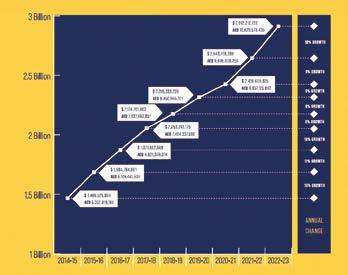
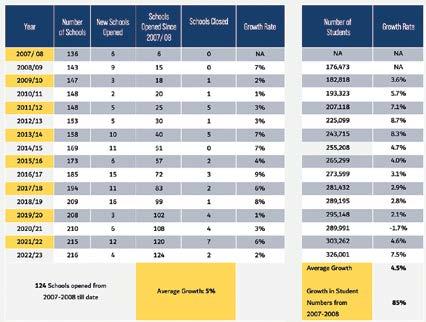
Dubai’s independent school sector experienced growth throughout with the Covid-19 pandemic, with the opening of six new schools and an overall revenue increase of 5%. In the 2021-22 academic year, 12 new schools opened, and growth in revenue nearly doubled. Thanks to cooperation between school leaders and government authorities, schools were able to continue operating throughout the pandemic, initially switching to distance learning, then offering a blend of distance and face-to-face learning. All schools returned to full-time face-to-face learning in October 2021.
An area of significant future growth in Dubai’s independent education sector is in early childhood education (newbornto-six years old). Approximately 70% of children in this demographic are not yet enrolled in an educational institution, providing ample opportunity for investors to step in and meet supply gaps
as demand increases. In December 2020, Dubai passed a resolution which enabled schools to open early childhood centres under their current school permit. Since then, 11 schools have done so.
KHDA also works closely with the Knowledge Fund, a Dubai government entity which manages land and building assets specifically allocated to the independent education sector. KHDA also maintains close contact with land banks and private landlords.
Dubai’s economy is growing. Government leaders have set out farreaching strategic plans, reflected in
KHDA’s approach to encouraging greater investment in high-quality independent education. As more families move to Dubai, its independent school sector will become a centre for world-class education, recognised by investors and operators for its growth opportunities and transparent regulatory environment, and valued by families for its diversity and quality.
Mohammed Darwish is chief executive officer of permits and compliance for the Knowledge and Human Development Authority.
Phil Holdcroft has faced daunting challenges in military conflict but nothing prepared him for a challenge closer to home


At 43 years old, I’m taking a moment to reflect on resilience. What exactly is it? How do we become resilient? And what can we do to support the resilience of future generations?
For a start, I’d encourage you to be deeply suspicious of anyone claiming to be an authority on resilience. I’d be the first to admit that, despite my passion for the topic, I’m very much a work in progress when it comes to resilience. I say this having served 20 years in the Royal Air Force as a combat helicopter pilot, having been shot at and mortared while deployed on operations in Iraq and Afghanistan. I also say this as a veteran of extreme challenges of endurance, having run 100-mile ultramarathons and rowed unsupported across the Atlantic Ocean. Why the scepticism? It’s because I once had my rug of resilience ripped out from beneath my feet.
If you’d have asked me in the summer of 2014 if I was resilient, I would have told you “Yes, absolutely, completely… I’m bulletproof”. In my eyes I’d been on the receiving end of world-class resilience training thanks to my time in the military. Not only had I received world-class training, but I also believed I had innate resilience – a natural grit and determination to overcome adversity. I interpreted my instinct to seek out challenges right on the edge of the possible as irrefutable evidence of my ‘natural’ resilience. Surely, someone who ran marathons for fun and completed the backbreaking All Arms Commando
Course just for a Green Beret souvenir was mentally unbreakable?
Yet, despite believing that I epitomised resilience, weeks later I had completely unravelled. What happened? My youngest daughter, Isla, then 22 months old, was diagnosed with leukaemia. The news completely shattered my fortress of resilience. I simply couldn’t comprehend our new reality, and my world began to fall apart. I felt wholly ill-equipped to deal with the psychological trauma of the impossible journey that lay ahead.
Heroics on operations, Green Beret, pilot wings, resistance to interrogation training, and marathon endurance counted for nothing. Terrors from the battlefield of Iraq and Afghanistan paled into insignificance next to the horror of watching my own flesh and blood walk a tightrope of life and death. When I most needed to be resilient I felt completely impotent.
It was my wife Beth, a primary school teacher, who was the towering strength in our darkest hour. Beth hadn’t received military leadership training, she hadn’t been hardened on foreign battlefields, yet she showed strength and resolve I couldn’t conceive. How? She instinctively understood that resilience was so much more than natural ability and training. Beth knew that she needed to draw on the support of others. In short,
Beth recognised that resilience can be provided through the ‘social’ support of others. This knowledge allowed her to be vulnerable, to openly share her fears and insecurities. In doing so, she opened the floodgates to waves of help, support and reassurance that our family desperately needed.
Nine years later and Isla is a happy, healthy and thriving 10-year-old. In so many ways she’s a paragon of resilience. It’s as if what leukaemia tried to take away, nature has given back twofold. She’s both an early bird and a night owl, and she fizzes with a zest for life that allows her to flourish physically and academically. I simply couldn’t be prouder or more thankful that she survived.

“Why the scepticism? It’s because I once had my rug of resilience ripped out from beneath my feet.”Resilient Isla Isla finishes treatment
Reflecting back, I would never wish our experience on anyone. However, I would love others to see the world through our eyes and understand the incredible lessons we’ve learned – especially when it comes to resilience. So, what have I learned? What lessons about resilience would I want my school-aged self to understand in preparation for the big wide world?
• What is resilience? Resilience is ability to adapt and deal with stress, adversity and trauma. The greater our resilience, the better our response when things are tough. I think the model at Figure 1 does an excellent job of explaining how resilience can affect the outcome of a crisis. Resilience not only helps us to recover and avoid damaging consequences of a crisis, but it also provides the route to a positive outcome – post-traumatic growth.
• Resilience is multifaceted. Resilience is so much more than just grit and determination. Yes, I believe there is a ‘nature’ component to resilience. However, I also believe we all have the potential to increase our resilience through knowledge, training and social

support structures. As such, I believe we need to embrace a holistic approach to growing resilience.
• Self-awareness. We need to recognise strengths and vulnerabilities within our own resilience and the resilience of others. This is about understanding the unique and individual nature of resilience. In some contexts, for example, academic testing, an individual may naturally thrive, while in others, for example, domestic conflict, they may crumble. Understanding individual strengths and weaknesses helps us to make provision to reinforce resilience through education, training or social support structures.
• Resilience training. Carefully controlled exposure to stress is a proven mechanism to help individuals grow their resilience. This could be via physical exercise, academic testing, public speaking etc. The goal is to help individuals understand that personal growth and development requires exposure to stress. However, linked to self-awareness, it’s critical to understand that we each have unique profiles for what optimal stress looks
like, hence resilience training needs to be calibrated and personalised for the individual and the context.

• Support structures. Research demonstrates that social networks and access to support resources, such as coaching or counselling, is critical for supporting resilience. Schools, like all organisations, need to promote resilience support structures positively, to increase both access and understanding.
• Resilience project. Resilience should be viewed as a life’s work; a project which needs to be prioritised, nurtured and reinforced at every stage of life. At no point are you the finished project –we’re all work in progress. Childhood education represents a golden opportunity for children to start their resilience project.
Reflections on resilience has become both my passion and purpose to help equip others with the knowledge, skills and mindset to be resilient to adversity.
With a political power change becoming increasingly probable and the likelihood of a VAT levy on independent school fees, schools are industriously investigating ways to mitigate the increase. Many have already restructured, changing from single sex to co-ed or extended their educational offering to include older year groups, but for those likely to be hit hardest it’s a case of digging deep and contemplating more creative solutions.
One such consideration is a change of teaching structure, with schools seeking inspiration from outside the education sector. For example, considering a doctor-nurse model, where a smaller core group of higher paid and better qualified teachers lead the teaching side: planning lessons, researching subjects, and tackling only the most challenging cases (both lessons and pupils). Supporting them would be those with other skill sets, acting in more of an operational role, which has a lower qualification barrier to entry and with it a lower salary scale. Their responsibilities would be to roll out the pre-planned lessons and deal with the majority of pupils who don’t require specialist care.
The doctor-nurse model is an interesting concept. It certainly optimises the efficiency of the teaching process and there are other benefits too:

• Specialisation – the model recognises the need for specialisation in education. Just as doctors specialise in specific areas of medicine, the core group of highly qualified teachers would focus on handling the complex cases. For instance, they would focus on designing lessons for advanced or specialised subjects, addressing students with special needs, or handling challenging behavioural issues.
• Delegation – the model promotes the delegation of routine tasks to educators with a lower qualification barrier. This allows the highly qualified teachers to focus their expertise on cases that require more attention and specialised care. By dividing responsibilities, the workload can be more effectively managed.
• Efficiency – the doctor-nurse model aims to increase the overall efficiency of the teaching process. Specialised teachers can dedicate more time to developing innovative teaching strategies, staying up to date with the latest research, and addressing the unique needs of individual students. This approach can potentially improve student outcomes and teacher satisfaction.
• Career progression – the model provides opportunities for career progression, as educators who initially start in operational roles with lower qualifications can aspire to become specialised teachers. This creates a clear pathway for professional development and allows educators to build on their skills and knowledge over time. We all recognise that the implementation of any new model in education requires careful planning, evaluation, and consideration of various factors such as teacher training, recruitment, resource allocation, and student needs. The success of this model would depend on the specific context, available resources, and the support provided to educators in both roles. It would require effective collaboration between the highly qualified teachers and the day-to-day educators. With internal
consultation often cited as a weakness within schools, this model relies on crystal clear communication channels and a shared understanding of the goals and expectations.
It’s easy to envisage that fewer hours would be worked by the teacher, thereby their salary could be reduced accordingly. However, by being supported by parttime teaching assistant(s), this may well offset the savings in salary and may even add to the wage bill, but many schools deduce that they have few options remaining available to them. This year has seen catering and service costs heading skyward, and with maintenance, estates management and administration costs stripped back to a bare minimum, there’s unlikely to be additional budget for the part-timers.
Thought must also be given to determine the most efficient method of recruiting this new breed of teacher. Gone are the days where staff are happy to muck in and help at any level. Those academic teachers fresh into the sector already perceive their specialisations as being of higher value, and are already questioning the reasoning of expending time on subjects in which they have little or no interest. Returning to the doctornurse analogy, we can draw a comparison to the situations many GPs currently find themselves in, where the time spent doing the job they have trained for and are so
“The doctornurse model is an interesting concept. It certainly optimises the efficiency of the teaching process and there are other benefits too.”
passionate about, has reduced to such an extent that many are choosing to leave their profession.

There’s a concern too that removing duties from teachers, taking away the task of lesson planning and distancing them from the majority of pupils, could in essence make teaching harder. By the very nature of the job, teachers are the ones who are responsible for pupils' learning. By removing their ability to plan and flex their lessons, they could lose those important nuances of teaching style that delivers the difference between good teachers and great teachers. With fewer
teachers, schools may start to lose the ‘family’ feeling, which many cite as their unique selling point. Parents recently attending school speech days, may have noticed the nods and smiles exchanged between pupils and their teachers, the obvious pride in both having shared a successful learning journey. Could these influential and irreplaceable relationships be lost?
Shared resources with neighbouring schools, lessons to maximise specialist teacher time for subjects with a low take up, larger classes with more reliance on teaching assistants are also considerations. Nevertheless, they do bring with them the threat of unsettling parents at a time when schools are looking to emphasise the added value of an independent education. Parental expectation of fee increases is that there should be better quality teaching delivered with them, and the new structure may prove to be a tough sell. Reducing the range of specialist topics available is also a key consideration, with greater focus returning to core subjects. Yet for those schools that have been banging on about their broad offering and fancy pants subject spread, a sudden subject strategy U-turn will be difficult to justify to those
parents who selected that school for that very reason.
However you cut it, independent schools are having to become far more commercially minded, far more creative, and are faced with challenging their traditional teaching methods. With that comes change – change to the types of people they are recruiting and a fresh approach as to how those changes are communicated, both internally and to their customer base. New staff recruitment will be key, securing staff with the ability to manage and, more importantly, securing those who are prepared to step back from day-to-day teaching to spend more time planning. This will signal a sea change and create a race to secure staff already in the market who demonstrate the right characteristics. The next few years will prove fascinating, and a time of frustration and failure for those who have yet to get their strategic game plan up to speed. Much like our doctors and nurses, weathering the crises faced by independent schools will be wholly dependent on whether we can encourage enough of the right people into the job, and whether there is enough cash in the coffers to pay for them.
“Thought must also be given to determine the most efficient method of recruiting this new breed of teacher. Gone are the days where staff are happy to muck in and help at any level.”
Apprenticeships specialist James Whybrow highlights how they can be used as part of your school’s workforce
The independent school sector is highly diverse, with more than 1,800 schools offering educational excellence through academic provision and enrichment programmes, boarding and day school options, and ranging in size from 300 to 2,500 pupils.
Independent schools date back to the sixteenth century and while much has changed over time, the underlying principles and philosophies remain consistent albeit updated to reflect the needs of the twenty-first century.
It could be assumed that with their long-standing traditions, heritage, reputation for excellent educational practice and place within communities that independent schools are better placed than state schools and others to attract and retain the talent and skills needed within the workforce. However, while this may be the case for some, it’s certainly not the case for all.
Schools are reliant on recruiting and developing enthusiastic and committed teaching and support staff, recognising that their skill and expertise creates an outstanding and well-managed school. Staff costs are consistently the largest single element of expenditure.
The broad range of job roles offered within schools align well
to apprenticeships, with examples where apprenticeships have been used including: leadership and management; information and communication technology; catering; health and safety; administration; finance; HR; facilities management; school business management; and the teacher apprenticeship training programme. There are approximately 700 different apprenticeship standards approved for delivery, so whether schools are looking to recruit and develop teaching staff, teaching support staff, pastoral, support fundraising, marketing, premises, catering and infrastructure roles, there are apprenticeship standards available.
The Apprenticeship Levy is a levy on UK employers to raise funds to pay for apprenticeship training and assessment. It is charged at 0.5% of an employer’s pay bill, but each levy paying employer receiving an allowance of £15,000 to offset against their levy payment. Because of the allowance, only employers with an annual pay bill greater than £3 million have to pay the levy. Levy payments are made monthly to HMRC. Employers have 24 months to use their funds once they enter their digital account, after this point funds will expire and become
part of general taxation receipts for HMRC. Employers can only spend their levy funds on apprenticeship training in England.
Once an apprenticeship programme and training provider has been selected and a price agreed, your provider will be paid out of your digital account every month.
If you do not pay the Apprenticeship Levy the government will support the cost of the apprenticeship through a co-investment rate where the employer is required to contribute 5% towards the agreed cost of apprenticeship training with the government paying the remaining 95% up to the apprenticeship funding band maximum.
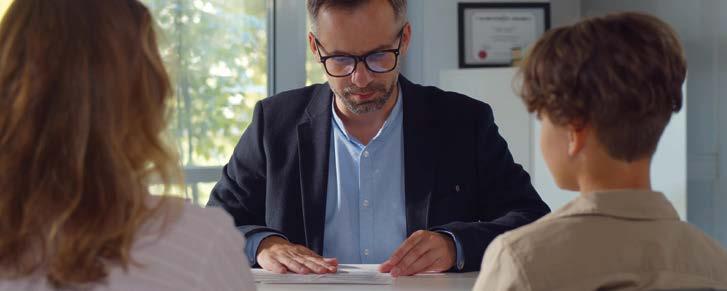

Prioritising the objectives and business areas where apprenticeships are the right option is critical. And you should already be negotiating fees with your procured and chosen training provider to ensure value for money, and already have measures in place to ensure that apprenticeship monies spent are having a positive impact. Additionally, alternative support is available for those business that have spent up to and over their levy, with the government co-investment rate set at 95%. Also, local authorities and Local Enterprise Partnerships have regional funding and grants available, so it’s worth checking with them to see if any additional incentives may be available.
Employers that pay the Apprenticeship Levy can choose to transfer up to 25% of their levy funds each year to other businesses of their choice, to pay for their apprenticeship training and assessment. Employers who are unable to spend their own levy may seek beneficiaries to donate unspent levy monies to.
Employers that pay the levy can also receive Apprenticeship Levy funds from other Apprenticeship Levy paying employers to support the costs of apprenticeship training. Transferring levy funds is a way of supporting
other businesses or charities by giving something back to your community. You can decide which sectors, skills or local areas you would like to fund.
Transferred funds can only be used to pay for apprenticeship training and assessment up to the funding band maximum. Transfers can only be used for a new apprentice start. This does not mean the apprentice has to be a new employee. It means you cannot receive transfer funding for an employee who has already started their apprenticeship.
Independent schools use a range of initiatives including staff committees, organisational structures, development programmes, surveys and performance reviews to gain insights and feedback on the development needs of its workforce. While apprenticeships are not new or the only initiative, they are one of the most effective tools available. An apprenticeship strategy could help to:
• Address skills gaps, increase retention and supply career development opportunities

• Attract future external talent to the business through fulfilment of job opportunities where an apprenticeship programme can support the transition into the job role and widen the access pool of candidates to include those new to the industry and/or those transitioning from one industry to another
• Enable service areas to find skills gaps, embed apprenticeships into their workforce planning and supply a clear pathway for employees to progress within the business, creating a talent pipeline
• Increase the skills and professional
qualifications of employees and
• Create talent and succession opportunities across the organisation to nurture talent and reduce an ageing workforce.
There’s no one right way to implement or develop a strategy for apprenticeships. Defining your goals and managing the associated risks will help you maintain your long-term vision.
If you’re just getting started with apprenticeships, or you want to get more from your existing programme, having a proper strategy in place is crucial to achieving an effective apprenticeship programme. It’s worthwhile taking the time to consider the following questions:
• Have you got a specific apprenticeship strategy, or are apprenticeships highlighted in your workforce planning, people or wider talent strategy?
• Have you defined your apprenticeships’ objectives and desired effect?
• Are you clear as to whether your apprenticeship programme is meeting your expectations?
• Is your apprenticeship programme meeting the regulatory requirements of the Education and Skills Funding Agency?
• Are there clear owners and advocates for apprenticeship development and Apprenticeship Levy spending?
• Would you consider your apprenticeship programme to be high quality and delivering impact? Would your apprentices agree?
• Are you highlighting the opportunities and effect apprenticeships have had on the school?
“Schools are reliant on recruiting and developing enthusiastic and committed teaching and support staff, recognising that their skill and expertise creates an outstanding and wellmanaged school.”
Carolyn Reed and Katie Cardona set out the protocols for making effective change while keeping stakeholders on board
Never in the history of the independent schools’ sector has there been such a flurry of activity.

The threat of an impending Labour government with its promise of the addition of VAT to school fees, the cost of living crisis, and increasing operational costs have created the perfect storm. Even the most financially secure schools are examining ways to ensure long-term stability, sustainability and with a fair wind, some growth.
Potential solutions are numerous. External investment, a buyout, partnership with another school, extension of year groups either at the top or bottom, or even conversion to academy status are all options on the table. Each one involves change – change for governors, parents, staff, alumni and frequently for the pupils.

Change can be positive but equally many people dislike it, especially when it involves a change to their best laid plans for their children which they have frequently spent time deciding upon. Changing from a girls’ school to a mixed environment when you have deliberately selected single sex, a move from one location that is walking distance from your home to one that involves a car journey. The list of changes goes on and can initially be unsettling for parents. Staff too will experience change in different ways depending on what it means for each of them.
Handled in the right way though, difficulties and backlash can be mitigated and even result in stakeholder support. Here are our top tips for managing change in your school:
Start any change project by undertaking robust research to help you better understand the market in which you operate. This will help you to make the right decisions regarding your future and also provide valuable information regarding your competitors. Data that is invaluable includes knowing what changes your competitors are making. This could be information about changes to their structure, or building projects they are undertaking or transport links they are introducing or strengthening. Knowing what’s happening generally in the market is essential too, for example, getting information about population projections in your area and finding out about proposed building developments that could affect your ability to recruit.
Governors play a crucial role in any change project. The project will have been instigated as a result of their strategic direction and therefore they must take responsibility and be active in all stages of
the project.
Governors will be working with the head and senior leadership team in working out the finer details of the change project. They must ensure they have thought about every single aspect of the change and how it will affect each stakeholder. This might be as elementary as how lunch arrangements will be affected, to the much bigger topic of staffing.
All these details need to be in place before any attempt can be made to create the communications that will form the key part of the change project launch.
In cases of a merger or acquisition, each party should form a working group to deal with the process of change. It will be the responsibility of the working groups to iron out all the details and oversee the process of due diligence.
Clarify what the result of the change is going to be because this will become the school’s new vision and is crucial to the way in which you tell others about the project. Positivity, improvement, excitement and meeting the needs of your parents are all aspects to consider.
It will then make a huge difference to all stakeholders if you make that vision real.
As we all know, a picture is worth a thousand words, so gather together all the visual material that you have. This
“Handled in the right way though, difficulties and backlash can be mitigated and even result in stakeholder support.”
will come from architects, classroom designers, uniform suppliers, brand specialists who have created a new logo for you and even from your archives. All this will help you to tell your story in the most compelling way.
At launch stage, it’s helpful to have a brochure that describes how you arrived at this decision, your rationale, and how the new structure will affect each year group. It’s helpful to know who the school leaders will be, if you know at this stage, as that is hugely comforting to parents.

First and most importantly, establish who your stakeholders are. This is a much longer list than might be imagined. For example, the parent stakeholder group is made up of all of the different year groups that will be affected and this could even be as granular as parents of boys and parents of girls. Parents will be most concerned about the impact the change is going to have on their child. Be sure to give them as much information as possible.
Sometimes staff seem to be considered as secondary stakeholders at the planning
stage, but their support is central to the success of the project. Be sure to be as open and communicative as you can bearing in mind that confidentiality is crucial in the early stages. It often happens that even at the date of the launch, the exact details of staffing in the new school structure are unknown. This situation needs to be handled with enormous empathy and understanding. Colleagues will be anxious about job security and what’s happening to their job in particular, and will need full support from governors, head and senior leadership team, as well as a clear understanding of the process.
Schools undergoing change should invite stakeholders to in-person events during the launch period. This is an excellent opportunity to show transparency, empathy and engagement. Where possible, have governors present and ready to engage and answer questions. A good way to prepare for this is to have a level of media training where all the worst questions are thought of and answers are considered and rehearsed. Should a question be asked that you
haven’t thought of, don’t worry. It’s perfectly acceptable to say you will come back with the answer. Honesty is the best policy and stakeholders will welcome the offer of a personal conversation, if that’s needed.
You might be heaving a huge sigh of relief once you’ve told your community about the change.
But don’t crack open the Champagne just yet! Even with meticulous planning, it sometimes happens in the days after the launch that critics make themselves heard and this can stir up stakeholders who were otherwise perfectly happy. For example, it could be that a journalist is a parent or other stakeholder and is keen to get a negative story into the local press. Keep your ears and eyes open as pre-empting any trouble is by far the best way to deal with the critics. Be proactive in seeking them out. Invite them in to talk about any concerns they may have.
Establishing external relations can make a critical contribution to a school's finances. For most schools, though, the question is where to start. Ian McLean sets out the strategy for a successful launch
Why might your school be considering establishing a development office? Often, it’s a short-term view because there’s an immediate need for fundraising. But beware: for members of a school community to give, they need to feel appreciated and involved and, for this reason, a major part of development activity is building relationships, which can take some time.
International schools generally suffer from a transient community, with it being difficult to build a long-term involvement. However, developing a culture of giving (and of asking) through a consistency of development activities, will help to increase awareness and expectations. By highlighting development activity at the outset, new families enter the school with a more informed understanding of the importance of the development office.
Development should be appropriately positioned in the school structure and ethos, with its director being included as part of the senior leadership group. This sends a message both internally and externally that development is considered a crucial aspect of the school and its future.
positioned in the school structure and ethos, with its director being included as part of the senior leadership group. This sends a message both
The development office should integrate three key areas:
• Building relationships with alumni and parents and, ideally, managing the alumni relations programme
• Communications, including social media networks and
• Offering a mix of fundraising opportunities for the internal and external school community to support. In some schools, the office may be referred to as the office of external relations or the development and alumni relations office.
This is the fundamental tool of operation of a development office: knowing who is in the school community and what they do. There are a number of programmes available with after-sales helpdesks, all designed for precisely the requirements of a fully integrated office. Working in conjunction with social media sites will quickly identify alumni and groups who currently maintain their own networks. The resources needed to manage and work in a development office will vary according to the level of maturity of the school’s database, its fundraising history and its relationship with former students. If we assume there’s been little engagement with alumni, along with a low level fundraising programme, it’s fair to say that database management will be a high priority and an administrative appointment may be a suitable place to start. There will be a need, however, to develop a strategic direction for the development office, based on supporting the school masterplan. A more senior appointment should then follow and, as fundraising becomes integrated with a more productive alumni programme, additional staff may be needed as well.
Engaging the advice of outside counsel in this area will help to provide guidance,

direction and a purpose.
Depending on the availability of suitable space, it’s preferable to have the development office based at the front or central area of the school so the development staff are fully aware of visitors, either current or potential families or alumni. It should also be welcoming, comfortable and be near both the principal’s office and admissions office for ease of access.
If there is already an active alumni association, that’s helpful because the development office should become directly linked, offering support and sharing resources. Hopefully, the association will support the development office. If there’s no formal association, however, the development office should aim to create an interesting and varied programme of activity to encourage involvement and interest in the school. Social media sites are a vital part of an effective alumni relations programme. A fully operational development office will also be able to identify and nurture those current families who show interest in helping the school in whichever way they can. Parents often provide a willing and enthusiastic resource for development activity.
“Development should be appropriately
internally and externally that development is considered a crucial aspect of the school and its future.”
Every school community has individuals with a degree of influence and respect. This may be through personal achievement or their position or success in business or profession. Identifying a group of key individuals with expertise, enthusiasm and influence might form the nucleus of a development council that helps steer ongoing activities and sets an example to others. Business leaders who have a direct connection with the school will be obvious members of a development council.
As it engages in a variety of ways with members of the school community, the development office will be looking to identify, then nurture, those individuals who have the interest and potential to offer support.
At the same time, with a structure in place, and the readiness to work with and nurture key individuals, the school must be well prepared with a development plan that is inspirational and worthy of support. Any goals for fundraising should be ambitious but also realistic.
When everything else is in place with an engaged school community, an effective fundraising programme can be enabled to be successful. The aim is to develop a sustained programme that results in regular gifts from a growing number of people, mixed with major levels of support. In many international schools, the strength of relationships with companies is vital in securing significant levels of funding support.
It’s inevitable that there will be a cost to establishing a development office. In the early phases, there will be little return, but development is a permanent and long-term operation that over time will see sustained benefits. It must be viewed as an investment and an essential aspect of the school’s administration and not a short-term fix. As a rule of thumb, the first year will be pure cost, the second year will pay for itself, then the third year will cover all previous costs and begin to make a contribution to the school's finances. Some school leaders expect a faster return, but the cultivation process necessitates a longer term and patient approach.
From the start, it’s important to:
• Agree on realistic expectations
• Resource the office sufficiently
• Identify a leadership group to lead by example
• Create a development master plan for the school that will inspire potential supporters and investors
• Build an effective alumni and parent relations programme
• Concentrate on building relationships with key individuals
• Offer a variety of fundraising opportunities that add real value and are not based on desperation and
• Be ambitious and committed to success.
Ian McLean was a development director for 24 years, having worked at independent, boarding and international schools in Australia, the UK and continental Europe. He is now in his eleventh year as an independent consultant.

The latest benchmarking report from Independent Development Professionals in Education (IDPE) and the fundraising consultants, Gifted Philanthropy, is the largest and most comprehensive study of schools’ fundraising and engagement activity in the UK, demonstrating the impact of successful development programmes in driving community engagement and philanthropic support.
In all, 215 schools took part (190 independent, 25 state). The survey covered 2018 to 2021.
Key findings of the report:
• Total philanthropic income from development activity: £425 million
• 66% comes from major gifts
• Average return on investment: 3.6:1 by years 4-5
• There is a direct correlation between the age of the development office and return on investment
• It takes time to build relationships and create trust before you can reach your targets
• There has been a significant rise in fundraising for bursaries (66% in 2018, 85% in 2021)
• All types of schools can achieve fundraising success.
The report can be ordered from IDPE at: idpe.org.uk/2022benchmarkingreport
Development should be at the heart of a school’s central management function, but it’s no good just wishing and hoping for a lucky financial return. Ian McLean reports
The school development office is much more than simply a fundraising office and its performance should be judged accordingly. Development is not fundraising. Development is a strategic operation of relationships, communication and fundraising – in that order. It means the role of the development office is integral to the school and is more diverse than some believe as it sits at the hub of the school’s external relations.
Successful school development is based on building relationships primarily with parents and former students. Going deeper than this, however, is the importance of building and maintaining relationships with existing and potential donors, local community and businesses, and those individuals who have the interest, influence and enthusiasm to help in other ways.
The past year or two has been difficult for school development offices in the UK and it has cemented the need to base development and fundraising on relationship-building. Some schools have successfully begun appeals during this time, mainly for support of the school’s
on personal contacts, and also on a sense of engagement with the ‘school community’, alongside a communications strategy that keeps the school community well informed about the school, its progress and its plans.”
bursary provision and, in particular, for hardship cases which have developed into a more engaged relationship with alumni online.
Warm relationships are built on personal contacts, and also on a sense of engagement with the ‘school community’, alongside a communications strategy that keeps the school community well informed about the school, its progress and its plans. Major donors expect complete transparency both on the vision and planning and the financial picture before making any major financial commitment. This is highlighted regularly by potential donors as a key ingredient of proper engagement.
The role of development and fundraising is much more widely accepted when the development office is observed as the hub of parent and alumni relationships and a source of regular communication and event management. To keep the development office completely separate from an alumni office or the marketing department has the potential to delay the effectiveness of development efforts.
However, the past does not equal the future. Just because the school has established contact with former students, and research may show they have the capacity to help, it shouldn’t assume a level of support, contrary sometimes to the expectations of those in leadership positions whose focus may simply be the ‘bottom line’ or ‘where is the money going to come from?’. The development and nurturing of relationships through individual connections and event activity is essential when support is not obvious. Schools today benefit from the growth of development activity and fundraising within the education sector generally, with many families aware and accepting of similar activity and approaches from other schools and universities with whom
they may be associated. Integrating fundraising with alumni relations activity becomes a more natural process after a period of genuine ‘friend-raising’ activity. The development office must be actively engaged and spend time meeting people, with the brokering of key relationships often being a measure of successful development work.
The need for funds is naturally a major reason why a development office is established. In the past, a school would simply launch a fundraising campaign – usually guided by an expensive consultancy firm – with results often falling way below fundraising expectations. Then in the early 2000s schools began to see the benefit of a development office introducing regular fundraising alongside extensive engagement activity. Those schools that began this activity with a full understanding of the realistic time involved, have reaped enormous benefits over the past 20 years while, unfortunately, there are many stop-start examples where unrealistic expectations and time frames have been placed on the development office in a culture where asking for money was seen as crass, but yet expected to be carried out by a junior or inexperienced development officer.
It's no wonder these schools have not believed in development and the longterm approach when the motive was purely for short-term gain. The urgent need or desire to have another or an improved facility outweighed the realistic position and culture at that school at that time.
In every school, not many individuals or families can provide a transformational level of support, so building a fundraising culture over time, providing opportunities for the wider school community to contribute in some way, is the foundation for ongoing and growing levels of fundraising support. Overall, the
“Warm relationships are built
“It's no wonder these schools have not believed in development and the longterm approach when the motive was purely for shortterm gain. The urgent need or desire to have another or an improved facility outweighed the realistic position and culture at that school at that time.”
basis of a broad fundraising mix should include a combination of seeking major gifts, having a regular giving programme, promoting legacies as a way of support, as well as running an engaging programme of events.
Planning for an inevitable major fundraising campaign takes time, in particular to ensure its readiness to gain the support and acceptance of the plans that require a fundraising component. This does not necessarily come easily and is often only assured by conducting a feasibility study among key and influential individuals – those who have
the ability, enthusiasm and influence to make a difference. The outcome of such an independently conducted study can act as an insurance policy prior to launching such a campaign – it minimises the fundraising ‘hope’ factor.
The role of the head and governors working with the development office and a volunteer development advisory group is fundamental to the success of major level fundraising. Peer-to-peer giving especially, when the volunteer is also a donor, creates a powerful message to potential donors. The work of the development office in nurturing and guiding the strategy and relationships makes for an effective ongoing campaign and sustained levels of support.


The King’s School, Canterbury appointed Jude Lowson as its first female head, The Daily Mail reported.
The Kent school, which was established in 597, is a coeducational boarding school catering to pupils aged 13 to 19.
Lowson grew up in South London and attended local state primary schools before her parents moved to Belgium. On returning to the UK aged 13, she boarded at Sevenoaks School before studying history at the University of Cambridge. On graduating she worked in advertising at agency Bartle Bogle Hegarty.
She began her teaching career at Whitgift School in Croydon and was later appointed deputy head at Putney High.
at Wellington College in Berkshire and The King’s School
Canterbury, before joining Tring Park School, formerly Arts Ed School, in 2002.

Simon Larter-Evans succeeded Stefan Anderson as principal of Tring Park School for the Performing Arts, Arts Professional reported.

Tring Park School is an independent co-educational day and boarding school in Tring, Hertfordshire.
Larter-Evans began his career as a dancer following training at Rambert. He went on to work in PR and publishing before retraining as a teacher. He was previously head of boarding and English at Yehudi Menuhin School and most recently head of St Paul’s Cathedral School.
Anderson is retiring after 21 years working at the school and more than 40 years in education. He began his career
Samantha Price will move to Cranleigh
Samantha Price will become head of Cranleigh School, a coeducational boarding and day school in Surrey, at the end of the summer term next year.
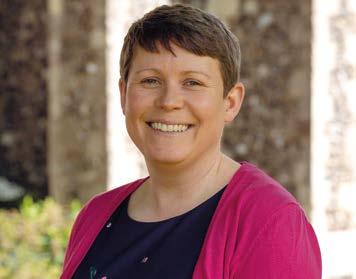
Price is currently head of Benenden, a girls’ boarding school in Kent.
Anna Birkett, chairman of Benenden’s governing council
commented: “During her 10 years at Benenden Mrs Price has presided over a period of sustained and exciting change and development at the school. Her headship has always been focused on ensuring that Benenden is a leader, not just in independent education but in the education sector as a whole in this country and, increasingly, internationally. She will end her tenure at Benenden as a widely respected leader in her field.
Kensington Wade appoints Huw May as head Kensington Wade appointed Huw May as its new head.
Kensington Wade is an independent prep school and nursery providing children aged three to 11 with a bilingual education in English and Chinese.
May was previously head of school at Eaton House Belgravia and was a head within the Eaton House Schools group for the past 10 years, and previously head of Roedean Junior School and Sydenham High School Prep (part of the Girls’ Day School Trust). He is also an experienced Independent School Standards inspector.
Prior to his teaching career May trained and worked as a professional classical singer at the Royal Welsh College of Music and Drama.
Lockyer to move to Milan
Simon Lockyer, headmaster of The Royal Hospital School is leaving in August 2024 to become the chief executive and principal of the British School of Milan.


Lockyer has been head of the Holbrook, Ipswich-based coeducational boarding and day school with naval traditions for nearly nine years.
Mark Pendlington, chair of governors, said: “Amongst many key achievements [Lockyer] has succeeded in broadening access to the school, including internationally, and has enhanced relationships between the school, the Royal Navy, our extensive community network and the alumni. Taken together with the development of our approach to philanthropic giving, most recently in the hugely successful ‘Launch 100 Lives’ campaign, all this will be an enduring part of his legacy at RHS.”

The Scottish Council of Independent Schools (SCIS) appointed Lorraine Davidson, head of education strategy at the Scottish government, as its new chief executive.
Davidson succeeded John Edward, who announced his departure from SCIS in February after 14 years at the organisation.
Davidson has experience in strategy development, corporate communications and crisis management. She was previously the head of communications for the Crown Office and Procurator Fiscal Service, and prior to that head of corporate communications for NHS Health Scotland. Earlier in her career, Davidson was a political correspondent for STV, the BBC and The Times.
Suzie Longstaff joined London Park Schools (LPS) as principal in April this year, a new senior schools’ group in London that is part of Dukes Education. The first LPS school, LPS Clapham, has just opened, with more to follow. As proponents of experiential learning, the new schools will take advantage of Dukes Education’s tall ship in the Mediterranean to study marine conservation, as well as its alpine school to study geology and erosion.
She was previously head of Putney High School, GDST, one of London’s top day schools.
Before moving into education, Longstaff had a successful rowing career, including coxing the British Olympic VIII at the 1996 Atlanta Olympic Games and the Cambridge University Goldie boat in the 1997 and 1998 Boat Races.
With a degree in economics from Durham, Longstaff has a PGCE in mathematics from Cambridge, a diploma in computing from Oxford, and a master’s in education from Bath. She is currently undertaking a part-time MBA. Her teaching career spans single sex, coeducational, day and boarding schools, including Shiplake College, Kingston Grammar School and Putney High School, GDST, where she was director of sixth form and deputy head academic before becoming headmistress in 2014. This year she was appointed as a governor of the Pointers School in Southeast London.
Longstaff’s rich life experience informs her dynamic, forward-thinking attitude to what an outstanding education can
be and she is an independent schools’ inspector and school governor. She encourages students to be both innovative and intrepid in their learning in an approach she calls ‘modern scholarship’ which is about making learning challenging, fun and relevant, exploring everything from entrepreneurship and oracy to design thinking and artificial intelligence.
Longstaff values sport, co-curricular activities, and community involvement as key to a rounded education and crucial in promoting good wellbeing in her students. She is a born leader who established Putney High as one of the UK’s leading schools: it was graded excellent with “exceptional” achievement in its last ISI inspection, ranked fifth for school sport nationally in 2020, shortlisted for the TES Independent Senior School of the Year 2022 and won a gold medal at RHS Chelsea Flower Show in 2021 for its groundbreaking research into the benefits of biophilia on wellbeing and academic performance.
Suzie was named as one of the i25 innovators and influencers in education in 2019. She is married, with twin daughters.
How many staff are there in your school?
LPS is a new group of co-educational senior schools – a new concept in modern secondary education that embraces the power of a smaller school to deliver bigger thinking. Staff work in their individual schools, but we are one team, working to the same overarching mission and vision – to deliver a new model of education developed for a modern world.
LPS Clapham is the first of our schools to go live – and we will be building on that model and recruiting more staff as we grow.
What has been the biggest challenge in your job so far?
Getting going with a vision of a new type of education for the modern world – one that is fit for the future, helps young people now, and sets them up for a new world; building a different model of education; being visionary – while still having to deliver the basics; acting like
a start-up with that level of energy and small team; having big plans.
What will be the likely next big challenge?
Taking it to the next level – rolling it out; helping to agree and develop what modern, sustainable and ethical education is for the next generation; looking beyond our borders to draw on best practice from around the world; looking beyond the restrictions of ‘education’ for great ideas and ways to innovate and inspire our pupils.
What is the most useful advice you have been given?
When you see an opportunity, keep pushing. It will be hard and takes effort but it will be worth it. This was learnt on the river but is equally adaptable for London Park Schools – or life in general.
Who has been the biggest influence on you in your career? How?
My father showed me the importance of kind leadership, the fun of business strategy and how to appreciate the great outdoors. Sadly, he passed away a number of years ago with early onset Alzheimer’s, but my memories of him at work have been instrumental to me. He really cared about his colleagues and was a very down to earth and pragmatic leader.
Please relate a funny story from your career.
I have many funny stories and happy memories and in common with many teachers, have some crazy early career stories. I have had to be rescued heading backwards in a launch towards a weir in full throttle, unable to stop as the gear lever had fallen off and I have been lost on Dartmoor during a gold Duke of Edinburgh practice expedition. What I’ve loved about teaching is the fun, the variety, and the experiences that one would never normally expect to find in an office.
What was the best money-making project you introduced – and how much did it make?
The best money-making projects I have introduced have been student-led
“Longstaff’s rich life experience informs her dynamic, forwardthinking attitude to what an outstanding education can be and she is an independent schools’ inspector and school governor.”
enterprise projects, such as the Ignite £5 challenge in my last school, where students had to build up their capital and sell their own made products to raise money for their house charities, or the Year 7 Entrepreneur Club which was scarily successful. I think it’s incredibly important to educate and encourage the next generation of entrepreneurs in the skills that may need to start their own business or develop a great idea.
What was the best cost-cutting project you introduced – and how much did it save?
With my educational background as an economist, maths teacher and head of IT, it may not be a surprise to read that I love looking at numbers and data and trying to think differently. Looking at our costs through a sustainability lens is my latest focus, saving money with an ecoconscience helps to galvanise support.
What’s been the biggest surprise you’ve had in school?
Winning a gold medal at Chelsea Flower
Show for Putney High School’s biophilic classroom research into the wellbeing benefits of plants in classrooms was a complete and wonderful surprise. Arriving at Chelsea Flower Show early in the morning to see the gold medal placed on the stand was a moment I’ll never forget.
What is your lasting memory so far?
During my first day in my first PGCE teaching practice, I successfully separated two Year 10 boys having a fight. I remember thinking, “I’m going to love
this job” and I was right. The variety, challenge, laughter and memories have all been wonderful and I’ve worked with the most amazing colleagues along the way.
What are your hobbies and outside interests?
As I am not that tall and don’t mind getting cold and wet, I’ve coxed many rowing crews over the years. I’ve always been drawn by the strong sense of team and absolutely love a tight race. At weekends, my routine is to run my local Parkrun on Saturday morning and then to escape down to my allotment, when I can. Getting some ‘me time’ is an important reset.
What are your personal future plans?
I’m excited by the opportunity to help develop schools that champion a modern approach to education and which, due to their size, can provide a more personal approach to education – while enabling bigger thinking. I love learning and I’m always keen to learn more and do better.

“When you see an opportunity, keep pushing. It will be hard and takes effort but it will be worth it.”
In the next edition we will dig into the areas of the school business often overlooked.
Topics include:
Head and bursar: what makes this special relationship tick?
Governance: consolidating gains made during the pandemic; alternative models.
Marketing and admissions: how did your school fare? What to do next.
International schools: the new hot spots for investment
Leadership: effective recruitment protocols for smooth succession planning.
Strategic change: getting stakeholders to buy into your vision.
Property: analysis of the changes in business rates.
Finance: trading subsidiaries and gift aid/difficulty of repatriating profits to the charity.
Finance: effective debt recovery from overdue fees.
Pensions: stick with the TPS or leave? Strategies and the potential effect on recruitment.
PR: how to manage bad news.
Risk management: decarbonisation of the school campus part 2.

IT: effective procurement to ensure software is current and fit for purpose.
Fundraising: building long-term relationships.
Fundraising: how to increase your lettings income.
News, people moves and more.
We welcome your views and any editorial suggestions. Please contact: andrew.maiden@nexusgroup.co.uk
29 September 2023
Business Design Centre, London
06 March 2024
Wokefield De Vere Estate, Reading


13 June 2024
Park Plaza Westminster Bridge, London
27 September 2024
Business Design Centre, London

independentschoolmanagement.co.uk/events




